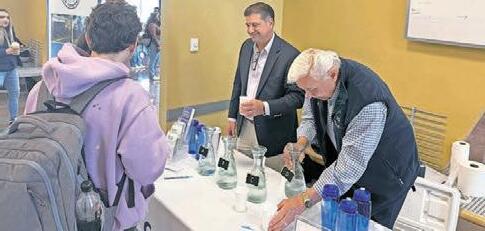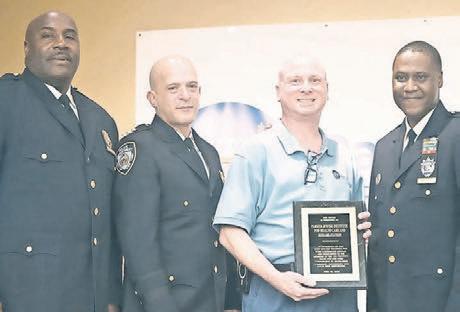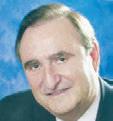


Courtesy Susan Saban
The Lynbrook High School track team hosted a practice on April 30 to give students with physical disabilities a chance to participate in sports.




Courtesy Susan Saban
The Lynbrook High School track team hosted a practice on April 30 to give students with physical disabilities a chance to participate in sports.
By AINSlEY MARTINEZ amartinez@liherald.com
From vocational training to peer mentorship, schools in Lynbrook and East Rockaway are expanding inclusive education programs for students with autism and other special needs, despite the need for an expanded budget, program directors say.
The Lynbrook school district has moved away from the traditional one-size-fits-all model of special education in favor of a more flexible, student-centered continuum of services, Susan Saban, director of special services, said.
The district now offers a range of classes tailored to varying levels of need, a shift that has allowed more students with disabil-
ities to be educated in their home schools rather than outside the district.
“In the past, students who needed more support were often placed in programs outside the district,” Saban explained. “But we’ve developed what we call a full continuum of special-education programs here in Lynbrook.”
They include self-contained classrooms capped at eight to 12 students, as well as integrated, co-taught classes that pair a general education teacher with a special education teacher in a mainstream classroom. This variety gives students the ability to move between classes based on their individual strengths and challenges, Saban said.
“They can be in a less restrictive environ-

By AINSlEY MARTINEZ amartinez@liherald.com
Lynbrook officials say that drivers — and passengers — should expect stricter enforcement of traffic laws, including seat belt violations, as part of an ongoing effort to improve public safety across the village.
Mayor Alan Beach said he had directed the Police Department to be more proactive on traffic-law enforcement, and that it was time to start issuing more tickets.
“I don’t want people to worry about getting hit by a car while crossing the road,” Beach said.
I
locations, looking for unbelted drivers and passengers, Lynbrook Police Chief Brian Paladino said.
“We have a sign, and some people come through and we wave them over if they don’t have a seat belt,” Paladino said.
He explained that enforcement focuses on visibility and compliance, rather than revenue.
t’s not supposed to be about just giving out tickets. It’s supposed to be about educating the public.
BRIAN PAlAdINo
Lynbrook police chief
The initiative comes as the department continues its participate in the Buckle Up New York grant program, a statewide effort to increase seat belt use through high-visibility enforcement and public education.
As part of the program, officers often position themselves at stop signs and other strategic
New York’s seat belt law was expanded in 2020 to require backseat passengers ages 16 and older to wear seat belts. Up to that point, only frontseat passengers and children under 16 were required to buckle up.
Violators who are 16 and older can be fined $50, plus a mandatory surcharge. Drivers can also be held accountable if their passengers are unbelted.
Paladino noted that officers often spot violations while observing traffic, and sometimes see children moving freely in vehicles.
“A kid walking around (in)
ConTinued on pAge 10

By AINSLEY MARTINEZ amartinez@liherald.com
Michael Van Wart is the Superintendent for Finance & Operations for the Eas t Roc kaway School District currently overseeing the district’s budget, which will go before voters on May 20 with a proposed levy increase of 1.95 percent.
Herald: What have been the biggest changes in the district’s budget from this year to last year? Were there any major challenges or achievements?
Van Wart: For us, the challenge this year has been fiscal. We’re in negotiations with the teachers right now, and what tends to happen is a lot of the agreements get front-loaded in the first couple of years. We’ve settled four contracts in the past year, and now we’re absorbing
all the salary increases in this year’s budget—plus the benefits we negotiated with them as well. State aid is always a concern. Because we’re small, about 20 percent of our budget relies on state aid. The rest is from the property tax levy. In New York State, the tax cap prevents us from raising property taxes by more than approximately 2 percent, with some fluctuation. So when state aid doesn’t increase significantly year over year, it creates fiscal challenges.
Herald: Have there been any sacrifices made in the budget this year?
Van Wart: Not for this year— knock on wood. We’re in a pretty good financial position. The former Assistant Superintendent, Mrs. Rio, who retired before I took over, put the district on a good long-term trajectory. During the pandemic, a lot of
federal funds came in, and schools across the state received a decent amount of federal support. Some districts used that money for recurring expenditures—things that carry over year to year. This past year was the last year for that federal funding. If you didn’t plan well to absorb those recurring costs into your operating budget, you could be in the position that a lot of districts are in now—having to lay off staff. In our case, we were not in that position. Much of the federal funding we received went toward non-recurring costs, like HVAC improvements for better ventilation and filtration. Where we did add staff using that funding, we planned to absorb the cost later through the operating budget. So we’re in a relatively good financial position.
Herald: Do you know how much of the funding for these types of extracurricular or innovative items, like 3D printers or therapy dogs, comes from the Educational Foundation compared to the operating budget?
Van Wart: It’s a very small percentage. Our operating budget last year was $45.2 million. The Foundation typically provides a couple thousand dollars

a year. I believe their endowment is never more than $40,000–$50,000. It depends on the year, but they try to support us as much as they can financially.
Herald: In Lynbrook, I heard there’s a disconnect between the special education funding formula and actual costs. Does East Rockaway deal with similar issues?
Van Wart: Yes. I’ll keep it relatively high-level, but here’s how it works. The state gives aid for high-cost students—you can think of it like a deductible. Each student may require services like speech, physical therapy, occupational therapy, or even a one-on-one aide. All those costs are added up for the student. If they cross that deductible threshold, the costs beyond that point become aidable. The issue is whether that deductible threshold is appropriate. For a district our size—East Rockaway has about 1,100 students and 150 teachers—we don’t have the economy of scale that larger districts do. Given our $45 million budget, that’s a sizable impact. And we don’t see the aid for that until the following year or even two to three years after.
Herald: How does the district plan to deal with
unfunded mandates, such as the electric vehicle bus requirement?
Van Wart: The zero-emission bus mandate still affects us, but not as severely as districts with 50–60 buses. Still, we’ll need to buy electric chargers and eventually replace our buses. The state did allocate funding toward this transition in the upcoming budget, and they’ve created some waiver processes, but we don’t know all the details yet. We’re trying to figure out what it’s going to cost. Maintenance for EVs is still a question mark.
Herald: If you had unlimited funding—or even just a little more—what would be your “dream” project for East Rockaway?
Van Wart: That’s a tough question. But I think we’d love to have a pre-K center. Right now, our pre-K program is mostly offsite with community-based organizations. We definitely have space constraints—our central administration is in the high school. If we had the funds, we’d build a dedicated pre-K facility, create new instructional spaces, and bring those programs in-district. It would absolutely be something instructionally focused—creating additional opportunities for students.
Saturday, June 7, 2025 10 a.m.
At Hofstra University, graduate students grow the seeds to advance in their career. Hear from representatives across 200 programs that include business, communications, education, engineering, health sciences, nursing, and psychology, and learn all the ways your success can sprout at Hofstra University. Your future awaits.
For event details and to RSVP, visit hofstra.edu/visit

By AINSLEY MARTINEZ amartinez@liherald.com
In her award-winning fea ture, “Le t’s Talk: Building Bridges Thr ough Language,” sen ior Cassandra Lev inson highlighted how Danaia and Aruuke Omuralieva fou nded an ini tiative to hel p int ernational students practice English with native speakers— offering a safer, more personal alternative to ran dom onl ine pla tforms. Through an Instagram account and website, the sisters connected mor e tha n 100 lea rners fro m aro und the world wit h stu dent volunteers, creating a space for language learning and cultural

HoRIZoN STAff
exchange. That sto ry ear ned Levinson a New York Pre ss Clu b Awa rd and rea ffirmed her com mitment to jou rnalism tha t fos ters emp athy and und erstanding, she sai d. Bel ow, Lev inson shares her approach to reporting, her passion for peo ple-centered stories and her tho ughts on wha t it means to give a voice to others.
Herald: Was there a particular moment that made you realize the “Let’s Talk” story needed to be told?
Levinson: Yes—on a Student Diversity Council trip, I connect-
ed more deeply with Danaia and her sister, Aruuke. I speak Bulgarian, and they speak Russian, so the re was thi s int eresting overlap in language and culture. Even though we couldn’t fully understand each other, we found common ground. That interaction really moved me. I t rem inded me that lan guage can be a barrier, but connection doesn’t always require perfect words. That rea lization stu ck with me and helped shape the narrative of the piece.
Herald: When did you first get involved in journalism?
Levinson: I’ve been writing since I was little. In fifth grade, I started a mini newspaper with my friend John Alongo—who’s act ually my co- editor-in-chief now It was small and fun, but it sparked something in me.
I ’ve alw ays loved wri ting and was inspired by journalists like David Foster Wallace. I joined the paper my freshman year and took journalism class right away. Ms. San ders, our adv isor, has bee n an inc redible men tor— she’s rea lly hel ped sha pe my writing and encouraged me to dig deeper.
Herald:What does your
reporting process look like?
Levinson: I’m driven by passion. It’s hard for me to write abo ut som ething I don’t car e about, which is why I gravitate toward people-focused stories. I rea d a lot and try to sta y informed, but what really motivates me is human connection. Interviews are my favorite part. The level of depth and emotion you can rea ch whe n spe aking with someone in person is really powerful. Capturing that in writing is bot h a cha llenge and a privilege.
Herald: Would you consider this story a form of solution journalism?
Lev inson: Abs olutely. Our school is lucky to have supportive faculty, but for international students, the hardest part can be the soc ial pie ce—making friends, feeling included. Programs like Let’s Talk are so important because they give students a way to connect beyond aca demics. It’s abo ut bui lding bri dges, not jus t through language, but through empathy. I think fostering that kind of dialogue is one of the most meaningful things we can do.
Herald: Where were you when you found out you’d won the Press Club award?
Levinson: I was at a Horizon meeting. Ms. Sanders does this suspenseful reveal whe never someone wins something. She listed the nam es, and the n I heard mine. Awards are great, but the real reward is when someone reads a story and feels seen or understood. If my writing can make even one person feel connected, that’s everything.
Herald: Do you see journalism in your future beyond high school?
Lev inson: I’m not ent irely sure. I’m thinking about majoring in philosophy, maybe pursuing a dual degree. I love research and academia, but I als o love writing. Jou rnalism let s me explore anything I’m passionate about, and that’s what I find so fulfilling.
No matter what, I’ll kee p writing—whether it’s jou rnalism, essays, or something totally different. I just want to keep telling stories that matter.
The Lynbrook Rec reation Dep artment has released its schedule of youth programs for Summer 2023, offering a range of activities for children ages 1 through 15.
The five-week session runs from Monday, July 10 through Friday, Aug. 11, with classes in arts, dance, movement, and crafts. A sensory class for 1-year-olds meets Tuesdays fro m 10 to 11 a.m ., while toddlers ages 2–3 can join Toddler Time on Mondays or Wednesdays and a Creative Movement class on Thursdays.
Preschoolers ages 3–4 can participate in a daily mor ning playgroup, ballet, hip hop, storytime arts and crafts, or Pre-K acro. Children ages 5–10 have access to age-specific classes in acro, ballet, hip hop, and arts and crafts, with a special three-day art camp offered Aug 22–24.
Older youth, ages 10–15, can sign up for tween and teen dance classes, a mini tie-dye session, and a conditioning and strengthening program.
Registration and full details are available by visiting Lynbrook.RecDesk.com.
The Lynbrook Recreation Department has released its schedule of youth programs for Summer 2023, offering a range of activities for children ages 1 through 15.

Age 1
■ Sensory Class Tuesdays | 10:00 a.m. – 11:00 a.m.
Ages 2–3
■ Toddler Time I Mondays | 12:00 p.m. – 1:15 p.m.
■ Toddler Time II Wednesdays | 12:00 p.m. – 1:15 p.m.
■ Creative Movement Thursdays | 1:00 p.m. – 1:45 p.m.
Ages 3–4
■ Preschool Playgroup Mon–Fri | 9:30 a.m. – 11:30 a.m.
■ Pre-K Acro Tuesdays | 1:00 p.m. – 1:45 p.m.
■ Preschool Ballet
Mondays | 2:30 p.m. – 3:15 p.m.
■ Storytime Arts & Crafts Mondays | 2:45 p.m. – 3:30 p.m.
■ Boys & Girls Hip Hop Wednesdays | 2:00 p.m. – 2:45 p.m.
Ages 5–6
Acro
■ Tuesdays | 2:00 p.m. – 3:00 p.m.
Ballet
■ Tuesdays | 3:00 p.m. – 4:00 p.m.
Girls Hip Hop
■ Wednesdays | 3:00 p.m. – 4:00 p.m.
Ages 5–7
Boys Hip Hop
■ Mondays | 3:45 p.m. – 4:45 p.m.
Arts & Crafts
■ Wednesdays | 2:30 p.m. – 3:30 p.m.
Special 3-Day Art Camp
■ Aug. 22–24 | 10:00 a.m. – 11:30 a.m.
Ages 7–9
Acro
■ Tuesdays | 3:05 p.m. – 4:05 p.m.
Girls Hip Hop
■ Wednesdays | 4:05 p.m. – 5:05 p.m.
Ages 7–10
Ballet
■ Tuesdays | 4:05 p.m. – 5:05 p.m.
Ages 8–10
Boys Hip Hop
■ Mondays | 4:50 p.m. – 5:50 p.m.
DIY Class
■ Wednesdays | 3:45 p.m. – 4:45 p.m.
Ages 8–12
Contemporary Dance
■ Tuesdays | 4:50 p.m. – 5:50 p.m.
Special 3-Day Art Camp
■ Aug. 22–24 | 1:30 p.m. – 3:30 p.m.
Ages 10–15
Acro
■ Tuesdays | 4:10 p.m. – 5:10 p.m.
Ages 11–15
Tween Hip Hop
■ Mondays | 3:45 p.m. – 4:45 p.m.
Ballet
■ Tuesdays | 5:10 p.m. – 6:10 p.m.
Tie Dye Mini Session (3 classes)
■ Wednesdays | 5:00 p.m. – 6:00 p.m.
Conditioning & Strengthening
■ Thursdays | 2:00 p.m. – 3:00 p.m.
• Pre-Arrangement Counseling
• Serving All Faiths
• Monuments
• Medicaid Approved Burial Trusts
• Funeral Directors available 24 hours a day
• Cremation Services
34 Hempstead Avenue (at Peninsula Blvd) Lynbrook, New York 11563 516-599-3600 • fax 516-599-3602 email: info@flinchandbruns.com www.flinchandbruns.com


“A
Continued
Serving All of Valley Stream with Tradition, Commitment, and Integrity since 1932
John F. Ferrante • Michael J. Grant Edward A. Bruns President Emeritus

Benjamin Franklin’s Poor Richard’s Almanac appeared from 1732 to 1758. Amongst other information, it provided pithy sayings and proverbs, many of which have withstood the test of time.
“An empty bag cannot stand upright.”
“Anger is never without a reason, but seldom a good one.”
“Anoint a villain and he’ll stab you: stab him and he’ll anoint you.”
“An old young man will be a young old man.”
“Don’t think to hunt two hares with one dog.”
“Eat few suppers and you’ll need few medicines.”
“Great almsgiving, lessens no man’s living.”
“Happy’s the wooing that’s not long a doing.”
“He that lies down with dogs, shall rise up with fleas.”
“If your riches are yours, why don’t you take them with you to the other world.”
“Lost time is never found again.”
“The noblest question in the world is, what good may I do in it?”
“They who have nothing to trouble them, will be troubled at nothing.”
“The sleeping fox catches no poultry.”
“The tongue is ever turning to the aching tooth.”

Five students from East Rockaway Junior-Senior
recently participated in the senior division of the Long Island Science Congress, an annual event that highlights student research in the sciences.
Five students from East Rockaway Junior-Senior High School recently participated in the senior division of the Long Island Science Congress, an annual event that highlights student research in the sciences.
The students presented their projects to three judges, who asked questions related to the research topics.
East Rockaway students received recognition in several award categories. Mia Salvador, Charlotte Webster and Mary Riordan received honorable mention. Eva Lam earned a Meritorious Award, and Andrew Chen received an Achievement Award.

Lynbrook Public Schools administrators and trustees honored dozens of student artists and musicians, gathering to celebrate this year’s All County artists, All County musicians, Long Island String Festival musicians and PEAK
musicians. Participants from Marion Street, Waverly Park and West End Elementary Schools, North and South Middle Schools and the high school were represented.
lynbrook/east rockaway
■ WEB SITE: www.liherald.com/lynbrook or www.liherald.com/eastrockaway ■ E-MAIl: Letters and other submissions:
Fax: (516) 569-4643








Clarke Senior Lacrosse
IT’S BEEN AN IMPRESSIVE rise for Clarke’s girls’ lacrosse program since it endured a winless 2022 campaign, and Kesabian has been a major part of the turnaround. Last spring she helped lead the Rams to 10 wins, scoring 26 goals and earning All-Conference honors in the process. This season, both the third-year attack and the team continued to flourish. Kesabian finished with 39 goals and 13 assists, and Clarke won 12 of 15 games.
Thursday, May 15
Softball playoffs: First round at higher seed ...................TBA
Boys Lacrosse: Freeport
G.N. South at V.S. Central ..........................5 p.m.
Friday, May 16
Boys Lacrosse: Garden City at Carey....................4:30 p.m.
Boys Lacrosse: Oceanside at Farmingdale................5 p.m.
Boys Lacrosse: Plainedge at South Side ...................5 p.m.
Boys Lacrosse: Massapequa at Syosset ...................5 p.m.
Saturday, May 17
Softball: Nassau quarterfinals at higher seed ................TBA
Monday, May 19
Softball: Nassau semifinals GM1 at higher seed ...........TBA
Tuesday, May 20
Softball: Nassau semifinals GM2 at lower seed.............TBA
Baseball: Nassau Class A quarterfinals GM 3 ................TBA
Baseball: Nassau Class B semifinals GM 2 ...................TBA
Baseball: Nassau Class AAA play-in games ...................TBA
High School athletes to be featured on the Herald sports page must compete in a spring sport and have earned an AllConference award or higher last season. Please send the following information: Name, School, Grade, Sport and accomplishments to Sports@liherald.com.
By PATRICK MOQUIN sports@liherald.com
With reliable playmakers and a few pleasant surprises, Lynbrook boys’ lacrosse has transformed from a contender to a juggernaut in Nassau Class B. With an 11-3 record and playoffs fast approaching, coach Bill Luzzi believes the Owls are capable of a deep run.
“We’ve knocked off a few teams that were above us in the preseason and a few teams that were below us,” Luzzi said. “Overall, we have a good, really fun, hardworking group of kids. They’re very coachable and responsive and we’re winning games. We’ve got a good feeling going.”
Last Friday, Lynbrook earned a massive 11-10 victory in overtime over Mepham to earn its seventh victory in Conference 2. Senior midfielder Jack LaBarbera buried the game-winning goal, continuing a stellar campaign as the Owls’ focal point on offense.
As expected, Lynbrook’s production has run through LaBarbera, who has 25 goals and 15 assists. He doesn’t lead the team in either category, but he requires constant attention from opponents and often creates opportunities for teammates as a result. When he does get chances, as he did against Mepham, he has been one of the most effective finishers in the county.
While LaBarbera and Luka Dantona, another senior midfielder with 23 goals and 15 assists, were always going to be major contributors for the Owls, other players have stepped up and thrived in larger roles. Senior attacker Eddie Stradowski currently leads Lynbrook with 28 assists while junior midfielder Brandon Scala is the leading scorer with 28 goals.
“Brandon Scala was a surprise to us,” Luzzi said. “We weren’t sure what we were going to get out of him as a junior, and he stepped into a starting spot and really owned it. He’s super scrappy, very tough.”
Lynbrook’s firepower doesn’t end there, as senior attackers Bennet Votano and Nate Greenfeld currently have 27 and 18 goals, respectively. In a largely unsung role, junior Thomas Dunne has won 162 faceoffs, kickstarting countless posses-

sions.
In his first season as starting goaltender, senior Luca Palleschi has been an improving standout. In the victory against Mepham, he made a career-high 23 saves.
In front of him, senior defensemen Billy Algozzini and James Paladino have led a tough Lynbrook defense that has held opponents to nine goals or less in 10 of 14 games.
Lynbrook had several young players with potential joining the roster or stepping up to a new role, and many of those members have delivered immediately.
Freshman utility player James Pisano is embracing physical play against older
boys while sophomore attacker/midfielder Patrick Algozzini already has 10 goals. For all of their success so far, one of the Owls’ three defeats was against Seaford, a team they set out to beat after a brutal 11-10 overtime loss in the playoffs last year. Lynbrook players had the game circled on the calendar and came up short, 13-3, but Luzzi remains optimistic that the playoffs could tell a different tale.
“Our goal is always to continue to get better and peak in the playoffs, and hopefully avenge a loss we had in the regular season if it matches up that way,” Luzzi said. “Lynbrook has a pretty good history of doing that.”




the car — that happens,” he said. “Five- or 6-year-olds not belted in … around the ’70s, that was cool. Now it’s not.”
National data supports the need for stronger enforcement. The National Highway Traffic Safety Administration reported that front seatbelt use was roughly 91.6 percent in 2022, while rear seat use lagged, at 81.7 percent.
In response to those numbers, NHTSA announced new federal regulations in December that will require all new vehicles to include rear seat-belt warning systems by September 2027. Front-seat warning systems will be enhanced starting in 2026.
Currently, 30 states, including New York, allow police officers to stop vehicles solely for seat belt violations involving backseat passengers. In neighboring New Jersey, officers can issue such a violation only if a vehicle was stopped for another reason.
Former Gov. Andrew Cuomo, who signed the 2020 update to the state’s seat belt law, cited research showing that about 30 percent of highway deaths in New York involved unbelted occupants. While 90 percent of adults in New York wear seat belts in the front seat, studies have shown that only 76 percent do so in the back, and even fewer buckle up in for-hire vehicles.
Paladino emphasized that the goal in Lynbrook is not punitive, but preventive. “It’s not supposed to be about just giving out tickets,” he said. “It’s supposed to be about educating the public.”








By AINSLEY MARTINEZ amartinez@liherald.com
Second story in a series on the Southern State Parkway.
Ana Marte, 67, said that a fatal car accident on the Southern State Parkway in January changed her life.
Her grandson Anthonie Marte, 23, was severely injured in a one-car crash shortly after 11 p.m. on Jan. 12, in the eastbound lanes not far from Exit 30, near Farmingdale and Massapequa, according to the New York State Police.
Investigators said that the car in which Marte was a passenger, a black 2016 Dodge Dart, was traveling at a high rate of speed and weaving between lanes before the driver lost control and crashed into a tree.
Two rear-seat passengers, ages 23 and 21, were pronounced dead at the scene. The driver, Jaden Dsouza, 19, of College Point, Queens, and Marte, of East Elmhurst, Queens, who was in the front passenger seat, were both extricated from the vehicle and transported to a nearby hospital in serious condition.
Marte’s grandmother said he suffered major head injuries, and she still takes care of him daily, feeding him and giving him pain medicine. He is slowly recovering, with doctors’ appointments and physical therapy. “He’s like a baby again,” she said. “He doesn’t want to go outside because he’s scared, and all he does is sleep.”
Marte does not remember the accident, his grandmother said.
Dsouza was later charged with one count of driving while ability impaired by drugs, second-degree manslaughter, first-degree vehicular manslaughter, second-degree assault and aggravated vehicular homicide, police said.

Crash data from the New York State Police shows a fluctuating, but persistent, pattern of accidents on the Southern State Parkway over the past six years, with the number of fatal crashes in a year reaching as high as six.
Crashes resulting in serious personal injury in Nassau have remained relatively low throughout the period, with no more than two reported in any given year.
While most incidents are non-fatal, serious crashes often involve an added risk: intoxication. Speed and distraction remain consistent contributing factors, but impairment by drugs or alcohol increases the potential for deadly outcomes.

“It’s on the driver for the most part,” State Police Capt. Mike Rhodes said. “If they’re inattentive, if they’re speeding, if they’re not following the vehicle and traffic law, they do not understand the severity of what could happen.”
Rhodes oversees 56 state troopers and eight sergeants, many of whom patrol the 25.3-mile long Southern State. Most accidents, he said, occur during peak congestion, at around 9 a.m. and 5 p.m.
Crash data from the state police show a fluctuating but persistent pattern of accidents on the parkway over the past six years, with fatal crashes increasing in 2024.
In 2019, there were 3,127 crashes on the Nassau County stretch of the parkway, including six fatalities. That number dropped to 2,331 in 2020, but rose again in subsequent years, reaching 2,716 in 2022 and 2,725 in 2023. In 2024, state police recorded 2,549 crashes and five fatalities. Thus far this year, there have been 328 crashes and one fatality.
“A lot of these things, they hit every single age category,” Rhodes said.
To combat the persistent problem, state police focus on enforcement and outreach. Not every traffic stop results in a citation; many serve as opportunities for education.
Personal injury attorney Stephen Cohen said that in his more than five decades of handling lawsuits, most of those that involve accidents on the Southern State involve intoxicated drivers.
Cohen, a partner at the law firm Cohen and Jaffe, in New Hyde Park, said that speed, intoxication and reckless driving continue to be the common factors in the region’s most serious accidents.
“I don’t believe road design is an issue at all,” Cohen said. “Posting more signs to slow down isn’t an answer, because when somebody is either speeding or just intoxicated, they don’t really care what the sign says.”
Many collisions during rush hour, he explained, stem from traffic congestion and insufficient braking distance. “People are gliding along, and they hit a certain spot, and all of a sudden they weren’t prepared, because they’re going 70 miles an hour,” Cohen said. “So you
see a lot of rear-end collisions, not necessarily death-related.”
Fatal crashes, he noted, often involve younger drivers, high speeds and intoxication or impairment.
“You don’t see fatalities at 11 o’clock in the morning,” Cohen said. “You just don’t. You may see them at 4 in the morning. When your ability to observe is not sharp because of either impairment or intoxication, the car is going to go airborne. And if there happens to be a tree there, that’s the next thing you’re going to hit.”
In his practice, Cohen said, the firm represents victims or passengers, but not intoxicated drivers.
Under state law, he noted, lawsuits require plaintiffs to meet the “serious injury” threshold defined in insurance law. In cases involving fatalities, death, families must petition a Surrogate’s Court to appoint a representative for the estate before filing a lawsuit. That process can take over a year, he said.
Insurance coverage limits often dictate how quickly a case can be resolved. “If somebody has — let’s say, the responsible party — has a $100,000 policy, that case is going to be over in two seconds,” Cohen said.
Efforts to reform wrongful death laws in New York have repeatedly stalled, despite advocacy from legal organizations.
Despite changes in laws and vehicle technology over the years, Cohen said, the root problems remain unchanged.
“It only seems to get worse because cars are faster than they were 20, 30 years ago,” he said. “There’s more people drinking or doing some sort of drugs. And that’s what you see in all horrific accidents.”
Additional reporting by Mohammad Rafiq.
2019 – Total: 3,987
(3,127 Nassau, 860 Suffolk)
Serious personal injury: 2 (Nassau)
Fatal: 8 (6 Nassau, 2 Suffolk)
2020 – Total: 2,977
(2,331 Nassau, 646 Suffolk)
Serious personal injury: 3 (2 Nassau, 1 Suffolk)
Fatal: 9 (6 Nassau, 3 Suffolk)
2021 – Total: 3,566
(2,782 Nassau, 784 Suffolk)
Serious personal injury: 1 (Nassau)
Fatal: 9 (6 Nassau, 3 Suffolk)
2022 – Total: 3,552
(2,716 Nassau, 836 Suffolk)
Serious personal injury:
5 (1 Nassau, 4 Suffolk)
Fatal: 13 (5 Nassau, 8 Suffolk)
2023 – Total: 3,500 (2,725-Nassau, 775-Suffolk)
Serious personal injury: 1 (Nassau)
Fatal: 6 (3 Nassau, 3 Suffolk)
2024 – Total: 3,405
(2,549 Nassau, 856 Suffolk)
Serious personal injury:
2 (1 Nassau, 1 Suffolk)
Fatal: 15 (5 Nassau, 10 Suffolk)
2025* – Total: 426 (328 Nassau, 98 Suffolk)
Serious personal injury: 0
Fatal: 3 (1 Nassau, 2 Suffolk)
* To date
By CHARLES SHAW cshaw@liherald.com
What’s the best-tasting tap water on Long Island?
That was the question posed to students at Farmingdale State College during the Long Island Water Conference’s 37th annual drinking water tasting contest, held during National Drinking Water Week.
The conference, also known as LIWC, is made up of members of public and private water suppliers across Long Island. According to LIWC Commissioner Robert McEvoy, the event has taken place at the Farmingdale campus for the past four years, sparking student interest in water quality.
“It draws in a lot of the students,” McEvoy said. “They’re interested in where the water comes from, and if there’s any variance in taste. We also try to promote tap water as being the most regulated and tested, even more so than bottled water.”
The finals, held on May 7, featured 16 Long Island water providers competing for the title of best-tasting drinking water in Nassau and Suffolk counties.
Students, faculty and staff on campus participated in a blind taste test, sampling water from each provider and casting their votes.
The Oyster Bay Water District won the Nassau County competition, while


the Greenlawn Water District took the top spot in Suffolk. Both districts will advance to the New York State Regional Metro Tap Water Taste Contest in New York City in August, where they will compete for a spot in the statewide competition held later that month at the Great New York State Fair in Syracuse.
LIWC representatives at the event also took the opportunity to educate attendees about the water supplied to their homes, and assured them that Long Island’s drinking water remains of high quality.
McEvoy, who is also a commissioner

and the chairman of the Oyster Bay Water District, said that frequent testing is conducted by the state Department of Health to ensure the water’s quality.
“It’s safe, it’s highly regulated and it’s extremely affordable,” McEvoy said. “It’s something that should be utilized by the public, and it’s a far greater value than bottled water.”
Michael Rich, a commissioner and the secretary of the Oyster Bay district, has taken part in the competition for the past 10 years, educating the community about local water supplies.
“It’s great to come out to the commu-
nity and have everyone get involved with local water,” Rich said.
He noted that most people aren’t aware of where their water comes from. On Long Island, drinking water comes from an aquifer system, a naturally formed underground storage area.
In an aquifer system, unwanted chemicals are capable of seeping into the water supply. The LIWC urges residents to dispose of hazardous household waste properly at designated town drop-off sites and never pour it down drains, into storm sewers or on the ground.
“Anything that we put on the ground will ultimately find its way into the aquifer,” Rich stated.
Lawn irrigation, he said, accounts for much of Long Island’s water use. He urged residents to follow odd/even watering schedules, watering on days that match their house numbers. He also highlighted the importance of leak detection, noting that undetected leaks can waste hundreds of thousands of gallons each month, making it vital for both residents and water providers to monitor and address them.
Rich added that it doesn’t take much water to maintain a healthy lawn.
“You don’t have to water your lawn for a half-hour a day,” Rich said. “You’ll get the same results 15 minutes a day, so we try to stress that.”
For more information on the local water supply, visit liwc.org.







ment where they’re strong and receive more support where they need it,” she said. “It’s a more responsive and inclusive model than what districts have traditionally offered.”
While the district has made strides in expanding services, however, Saban noted, the funding to support these programs hasn’t kept pace. Special education is primarily funded through local district budgets, with limited reimbursement from state and federal sources. The existing “excess cost” formula — intended to cover the difference between the cost of educating a general-education student and one with a disability — hasn’t been updated to reflect actual costs.
“We’re not getting the funds back to really support students in-district the way we should,” Saban said.
Nonetheless, she pointed out that other districts in the state don’t have the resources to expand programs the way Lynbrook has, for which she remains grateful.
At Lynbrook High School, special-education students in the Career Development Program participate in Owl Buddies, a weekly social group that connects them with general-education peers for fun and relaxing activities, Caitlin Hopkins, a special-education
teacher at Waverly Park Elementary School, said.
In East Rockaway, Ashley Tavormina, a special-education teacher at Rhame Avenue Elementary School, said these programs offer inclusion and support to students with special needs.
“It allows students to move throughout a lesson, request support or take a break if needed,” Tavormina said. “When students enter your classroom, they know it’s a safe space where advocating for their needs is encouraged and supported.”
Tavormina emphasized the importance of focusing on students’ interests when planning lessons. “If a student’s favorite color is purple, including purple in a non-preferred activity can help establish a connection,” she said. “If I find a student to be engaged when they hear someone sing, I’ll incorporate a singing component to the lesson.”
One of the most common misconceptions about autism, Tavormina said, is that autistic students have a limited ability to develop relationships. “I have been fortunate to witness students within my class who have created meaningful bonds and friendships,” she said.
In addition to peer connections, students in the Career Development Program at Lynbrook High take
part in LIRR Travel Training, which teaches them how to navigate the Long Island Rail Road by learning to reading schedules, and how to travel by train with minimal assistance, special-education teacher Bryton LaMantia said.
The program also includes Budget Buddies, in which business students teach financial literacy skills, and a community garden programs, in which students grow and harvest produce on school grounds.
“It’s a fantastic way for students to learn responsibility, teamwork, nutrition and the value of healthy food choices,” Career Development teacher Annie McKenna said.
In Lynbrook’s North Middle School, students run the Hoot Café, a student-operated coffee shop.
“Staff throughout the school look forward to the café being open and are provided with a chance to build connections with the students,” LaMantia said.
Lynbrook special-education students also take part in the Challenger Sports Team, a non-competitive athletics program.
“The most important thing to remember is how lucky we are as educators,” Tavormina said. “We get to teach students who have the biggest hearts and minds.”
By AINSLEY MARTINEZ amartinez@liherald.com
David Parnes is the outreach director at Yellow Bus ABA, a provider of autism therapy services with multiple locations across the region, including a center on Broadway in Lynbrook.
Herald: How do you respond to recent rhetoric — from Robert F. Kennedy Jr. and others — about autism and its causes?
David Parnes: Look, we welcome anyone willing to invest in autism services and research, as long as it’s rooted in science and evidence-based practices. If RFK Jr. brings real funding into the field in a responsible way, we support that.
But there’s also a double-edged sword when it comes to how autism is portrayed. Autism is a spectrum, and that’s not just a buzzword — it’s reality. Some individuals . . . live incredibly productive, independent lives. Others — espe-
cially those with severe communication challenges—may require 24/7 care and live in residential facilities for life.
When public figures or media say things like, “autistic children will never be able to play basketball or date,” it stigmatizes high-functioning individuals. On the flip side, overly idealized portrayals can minimize the very real, very intense needs that many individuals face. What we need is education and empathy. Autism isn’t one thing. It affects people in dramatically different ways.
Herald: For those who don’t understand Applied Behavior Analysis therapy, can you explain how it works — especially if it doesn’t rely on mimicking or mirroring behaviors?
Parnes: Sure, although I’m not a clinician, I can speak to the philosophy. Neurotypical children often learn by observing and imitating — for example, brushing their teeth because they see a
parent do it. Children with autism often don’t learn this way. So, ABA therapy breaks down tasks into very small, teachable steps.
For brushing teeth, that might mean teaching 20 distinct steps, like walking to the bathroom, picking up the toothbrush, putting toothpaste on it, and so on. The same principle applies to communication. We might teach a child that when they’re thirsty, instead of melting down, they can use a word or gesture — or an AAC device — to request water.
It’s all about structure, repetition, and consistency, tailored to each individual’s needs.
Herald: How can peers and coworkers be more inclusive of individuals on the spectrum?
Parnes: The most important thing is empathy. Understand that someone might communicate or process things differently — and that doesn’t make them any less capable. If someone is
blunt or doesn’t pick up on social cues, don’t assume they’re being rude. Just like we accommodate someone with a physical disability — say, building a ramp for someone who can’t use stairs—we need to think about accommodations in how we interact and support our neurodivergent peers.
Herald: Is there anything else you want readers to take away from this?
Parnes: Yes — empathy and awareness are everything. Families navigating autism often face intense emotional and financial stress. Children who cannot communicate are often in crisis and may end up in institutional settings unnecessarily. Others go on to lead vibrant, successful lives. It’s all part of the same spectrum.
We need to accept autistic individuals for who they are and also recognize and support those who struggle more profoundly. Both narratives are true, and both deserve attention.















Focusing on











Some people think that only people with mental illnesses have to pay attention to their mental health.
But the truth is that your emotions, thoughts and attitudes affect your energy, productivity and overall health. Good mental health strengthens your ability to cope with everyday hassles and more serious crises and challenges. Good mental health is essential to creating the life you want.
It’s always important to take stock of your mental well-being and its connection to overall health. Just as you brush your teeth or get a flu shot or other immunization, you can take steps to promote your mental health. A great way to start is by learning to deal with stress.
How stress hurts
Stress can eat away at your well-being, like acid eating away at your stomach. Actually, stress can contribute to stomach pains and lots of other problems, like headaches, insomnia, overeating, back pain, high blood pressure, heart disease and stroke, irritability, vulnerability to infection, and poorer brain functioning.
Stress also can lead to serious mental health problems, like depression and anxiety disorders. If you think you have such a problem, get help.
Of course you can’t magically zap all sources of stress. But you can learn to deal with them in a way that promotes the well-being you want — and deserve. You can figure out ways to cope better with whatever comes your way. And decades of research suggest which steps are most likely to work.
The evidence
The concrete steps mental health professionals suggest are not based on guesses, fads or advice from grandma (though she probably got a lot right). They represent hundreds of research studies with thousands of participants, often conducted over decades and backed by major universities or government agencies.
This research shows that how good you feel is to a fairly large extent up to you. No matter how stressful your situation, you can take steps to promote your well-being.
In order to maintain and strengthen your mental and emotional health, it’s important to pay attention to your own needs and feelings. Don’t let stress and negative emotions build up. Try to maintain a balance between your daily responsibilities and the things you enjoy. If you take care of yourself, you’ll be better prepared to deal with challenges if and when they arise.
Taking care of yourself includes pursuing activities that naturally release endorphins and contribute to feeling good. In addition to physical exercise, endorphins are also naturally released when we:
Do things that positively impact others. Being useful to others and being valued for what you do can help build self-esteem.
Practice self-discipline. Self-control naturally leads to a sense of hopefulness and can help you overcome despair, helplessness, and other negative thoughts.
Appeal to your senses. Stay calm and energized by appealing to the five senses: sight, sound, touch, smell, and taste. Listen to music that lifts your mood, place flowers where you will see and smell them, massage your hands and feet, or sip a warm drink.
Engage in meaningful, creative work. Do things that challenge your creativity and make you feel productive, whether or not you get paid for it — things like gardening, drawing, writing, playing an instrument, or building something. Make time for contemplation and appreciation. Think about the things you’re grateful for. Meditate, pray, enjoy the sunset, or simply take a moment to pay attention to what is good, positive, and beautiful as you go about your day.
Limit unhealthy habits like worrying. Try to avoid becoming absorbed by repetitive mental habits — negative thoughts about yourself and the world that suck up time, drain your energy, and trigger feelings of anxiety, fear, and depression.

Sometimes it all seems too much to handle
Keep your ‘thought life’ healthy and your stress level low
Life gives people plenty of reasons to be stressed.
Relationship problems, child-rearing issues, job woes and a lack of money are just some of life’s complications that can weigh people down — and cause health problems.
In today’s society, stress and change often are thought of as the same thing. Stress is a physiological and psychological response to a change in a situation the body and mind find to be overwhelming.
With the fast pace of work and home, being constantly inundated with technology and still wanting to have time to connect with those around you, life can feel overwhelming and stressful at times.
“It’s difficult to stay healthy and energized when stress is a daily reality,” says Dr. Greg Wells. “Chronic stress can damage your body, threaten your mental health, put a strain on relationships, and take the joy out of life.”
But there’s no reason to surrender to stress, Wells, author of “The Ripple Effect: Eat, Sleep, Move and Think Better,“ says. He suggests some techniques that can help you have a healthier “thought life” and recover from chronic stress.
Move your body. Rhythmic, repeated motion is particularly soothing to the mind and body. A long walk, cycling, swimming, or running will all work, but any kind of movement relieves tension, improves circulation and clears your mind.
Get into nature. Head to the garden or the park to lower your blood pressure, strengthen your immune system, reduce tension and depression, and boost your mood. “It’s stunning how good it is for your health to be in nature,” Wells says. “And I recommend you leave the cell phone and earbuds at home.”
Practice yoga or Tai Chi. Therapy, yoga and Tai Chi are good ways to decrease stress and anxiety, increase energy and boost the immune system. They also give you more staminaand improve the quality of your sleep. Have perspective. Don’t be so quick to conclude that you “can’t handle” a stressful situation. “This is truly a mind-over-matter opportunity,” Wells says. “Believing that you are strong and resourceful actually makes you stronger and more resourceful.”
Change the nature of your response. Research indicates that taking an active, problem-solving approach to life’s challenges relieves stress and can transform it into something positive. If you withdraw, deny the problem, or spend all your time venting, you’ll feel helpless. Instead, be determined to make a change, put effort into it, and plan for better results.
Practice slow, deep breathing. Start applying the power of deep breathing each day. It will make a huge difference. Wells recommends you start small by taking three deep breaths each time you sit down at your desk — in the morning, after breaks, after lunch and so on. It will help you become more patient,
Block time for single-tasking. Each day, schedule time in your calendar for focusing exclusively on one task. This task should be something that is important to you. “People love to talk about multi-tasking, but while doing several things at once might make it seem as if you are working hard, it’s an illusion,” Wells says. Your body and mind are not designed to work that way and it causes extra stress.
“Ultimately, it’s important to remember that your thoughts have a strong influence over stress levels,” Wells says. “What you choose to think about, or not think about, dictates how your body and mind react to everyday life.”
Photo: Stressful experiences are a normal part of life, and the stress response is a survival mechanism that primes us to respond to threats. Some stress can be considered positive; but when a stressor is negative and can’t be fought off or avoided — such as layoffs at work or a loved one’s medical crisis — or when the experience of stress becomes chronic, our biological responses to stress can impair our physical and mental health.
Parker Jewish Institute for Health Care and Rehabilitation proudly hosted the 2025 Medal Day for the New York Police Departments 105th Precinct.
At the ceremony, which was held in Parker’s spacious auditorium, NYPD officials recognized officers who exemplified extraordinary merit and excellence in their police duties. In attendance were community leaders and supporters, as well as family members who had gathered to show their appreciation.
Michael N. Rosenblut, Parker’s president and CEO, accepted an NYPD award on behalf of Parker. The award recognized Parker’s dedication to the 105th Precinct and Parker’s continued commitment to community partnership with local first responders.
“We were honored to host NYPD’s 105th Precinct Award Ceremony and show our support to New York’s Finest,” Mr. Rosenblut said. “These highly skilled, empathetic officers help ensure the safety

of the Parker Jewish Institute community each and every day.”
About The Parker Jewish Institute for Health Care and Rehabilitation
The Parker Jewish Institute for Health Care and Rehabilitation is headquartered in
New Hyde Park, New York. The facility is a leading provider of Short-Term Rehabilitation and Long-Term Care. At the forefront of innovation in patient-centered health care and technology, the Institute is a leader in teaching and geriatric research. Parker Jewish Institute features its own
Parker Jewish Institute • (718) 289-2212
Health memos are supplied by advertisers and are not written by the Herald editorial staff.
medical team, and is nationally renowned as a skilled nursing facility, as well as a provider of community-based health care, encompassing Home Health Care, Medical House Calls, Palliative Care and Hospice. Parker Jewish Institute is also home to Queens-Long Island Renal Institute (QLIRI) — providing patients with safe, comfortable Hemodialysis treatments in a relaxed setting — as well as PRINE Health — a Vascular Center offering advanced vascular services. The Center and QLIRI further Parker’s ability to expand access to essential health-care services to adults in the greater New York metropolitan area. For more information, visit parkerinstitute. org or call (877) 727-5373.



In a recent Mount Sinai South Nassau “Truth in Medicine” public health poll, 51 percent of metro area residents said they would consider drinking less as a result of the advisory by former U.S. Surgeon General Vivek Murthy, MD, linking alcohol use to certain types of cancer.
According to the Surgeon General’s advisory, alcohol consumption contributes to nearly 100,000 cancer cases and about 20,000 cancer deaths each year in the United States. Studies show alcohol use increases the risk for breast, colorectal, liver, and esophageal cancer, as well as cancers of the mouth, throat, and voice box.
The poll, sponsored by Four Leaf Federal Credit Union, has sparked a debate over the benefits of reducing or eliminating alcohol consumption, highlighting the tough road ahead for public health experts trying to shift behaviors. Although 58 percent of respondents agree that alcohol can lead to overeating and smoking, fewer than half—46 percent—said they believe it increases the risks of cancer. Meanwhile, 58 percent believe there is a safe level of alcohol that can be consumed without raising one’s risk of cancer.
“Alcohol is a carcinogen, so the more alcohol a person drinks — particularly over time — the greater their risk of developing an alcohol-associated cancer,” said Adhi Sharma, MD, President of Mount Sinai South Nassau. “It would be prudent to add the cancer risk to the warning label, which could have a dual effect of reducing alcohol-related accidents as well as a range of serious health complications, such as liver and heart disease, stroke, depression, and brain damage.”
Studies show that alcohol may increase cancer risk by disrupting cell cycles, triggering chronic inflammation, damaging DNA (which controls cell growth and function), and elevating hormone levels, including estrogen, which plays a role in breast cancer development.
“As a hepatologist and gastroenterologist, I remind my patients
that while complete abstinence is the safest path, reducing consumption (no more than 1 standard drink for women and no more than 2 for a man), staying hydrated, avoiding binge drinking, and supporting liver health with a balanced diet might help mitigate some of alcohol’s toxic effects,” said Pruthvi Patel, MD, Associate Program Director of Outpatient Hepatology, Division of Gastroenterology, Mount Sinai South Nassau, and Associate Professor of Medicine (Liver Diseases), Icahn School of Medicine at Mount Sinai. “But there’s no completely safe level when it comes to cancer risk.”
According to the American Association of Cancer Research’s 2024 Cancer Progress Report, 40 percent of all cancer cases in the United States are associated with modifiable risk factors like alcohol consumption. The Surgeon General affirmed in the advisory that, “The largest burden of alcohol-related cancer in the United States is for breast cancer in women, with an estimated 44,180 cases in 2019, representing 16.4 percent of the approximately 270,000 total breast cancer cases for women.”
Adding the cancer risk warning to alcohol labels may be the inspiration some need to quit drinking alcoholic beverages, as 54 percent of poll respondents say they generally trust warning labels on food and beverages. Seeing the warning in print could provide the motivation for the 20 percent (of those who said they drink alcoholic beverages) to act on their desire to cut back on alcohol.
“I strongly encourage everyone to make it a priority to consider whether they should reduce the amount of alcohol they drink,” said Aaron Glatt, MD, Chief of Infectious Diseases and Chair of the Department of Medicine at Mount Sinai South Nassau. “Additional benefits of drinking less include lowered blood pressure, weight loss, a healthier complexion, sharper mental clarity, balanced mood, reduced anxiety, and better liver function.”
Mount Sinai South Nassau has provided behavioral health and substance use disorder services to Nassau County residents for more than 50 years. The hospital is committed to providing the highest-quality treatment and support to children, adults, and
Health memos are supplied by advertisers and are not written by the Herald editorial staff.

A recent Mount Sinai South Nassau “Truth in Medicine” public health poll revealed that 51 percent of metro area residents said they would consider drinking less as a result of the advisory by former U.S. Surgeon General, linking alcohol use to certain types of cancer.
families with a wide variety of symptoms and diagnoses, from substance abuse to anxiety and depression to attention deficithyperactivity disorder and more.
The hospital counseling centers offer outpatient, in-person, and telehealth services in Baldwin and Hempstead; they accept a variety of payment options and use a sliding scale for uninsured patients. Treatment is provided in English and Spanish, as well as in more than 100 other languages via interpreter services. Call (516) 3775400 to schedule an appointment.

The new Fennessy Family Emergency Department at Mount Sinai South Nassau doubles the size of our previous emergency department, o ering 54 private exam rooms with clear lines of sight for physicians, nurses, and support sta . Our new emergency department also o ers a separate triage area, dedicated areas for children and behavioral health patients, and has been designed to reduce wait times and improve patient outcomes.
The Fennessy Family Emergency Department is located within the new Feil Family Pavilion, opening later this year, which will have 40 new critical care suites and nine new operating rooms, designed to support the most complex surgeries on the South Shore.
To learn more visit www.mountsinai.org/feilpavilion



Queens-Long Island Renal Institute (QLIRI), a 2025 Bests of Long Island winner and located at The Parker Jewish Institute, now offers a state-of-the-art Home Hemodialysis Program for people battling kidney disease. Those patients who also require Certified Home Health Care can access it conveniently through QLIRI’s affiliate, Parker Jewish Institute.
With QLIRI’s Home Hemodialysis Program, patients can transition from an in-center setting to receiving hemodialysis from the comfort of their home, using the Tablo Hemodialysis System. Enrolled patients are first trained by a registered nurse. The nurse provides step-by-step guidance four days a week over the course of four weeks, or longer if necessary. With this training, patients learn to use the system before transitioning to the convenience of home hemodialysis.
If needed, patients of Parker’s Certified Home Health Care Agency receive individualized nursing, medical, and rehabilitation services, so they can maintain maximum independence in the comfort of their homes. Home-care services can include skilled-nursing care; physical, occupational and speech therapy; home-health aides; medical social services; medical supplies; and 24-hour telephone availability.
Call (718) 289-2600 with questions. To learn more about QLIRI’s Home Hemodialysis Program, visit qliri.org.
For more on Parker’s Certified Home Health Care, visit parkerinstitute.org.


Health memos are supplied by advertisers and are not written by the Herald editorial staff.




By HERNESTO GALDAMEZ hgaldamez@liherald.com
U.S. Rep. Laura Gillen, a Democrat representing New York’s 4th Congressional District, and Republican U.S. Rep. Mike Lawler, of the 17th District, have reintroduced a bipartisan bill aimed at protecting access to in vitro fertilization across the country.
The Access to Family Building Act, which Gillen is shepherding with support from Lawler and Rep. Brian Fitzpatrick of Pennsylvania, seeks to federally codify the right to access IVF services. The legislation is in response to growing concerns that reproductive technologies like IVF are being threatened by recent state-level legal developments and court rulings.
During a virtual press conference on May 7, Gillen emphasized the importance of ensuring legal certainty for families relying on reproductive technology. Infertility, she said, is a widespread issue affecting Americans of all backgrounds, and she called for Congress to act swiftly to protect the procedure.
“We believe, like most Americans do, that the right to start and grow family through IVF should be protected,” Gil-
len said. “The Access to Family Building Act will simply ensure that IVF remains accessible to families in every state.”
Lawler echoed Gillen’s sentiments, sharing his own family’s experience with fertility challenges. He reaffirmed his support for protecting IVF access, calling it a nonpartisan issue with widespread public backing. Lawler also referenced other related legislative efforts he supports, including tax credits and insurance mandates to reduce the financial burden of IVF treatments.
“Access to IVF should not be a partisan issue,” he said. “We want to help people through this journey and certainly make sure that their right to IVF is protected.”
The press event also featured Barbara Collura, president and CEO of Resolve: The National Infertility Association, who stressed the emotional and financial toll of infertility and the need for guaranteed nationwide access to IVF.
“There are so many challenges that our communities face in building their families,” Collura said. “Our goal is to reduce and eliminate those barriers. We know firsthand that our communities want to know that IVF is protected in all 50 states.

According to the Centers for Disease Control and Prevention, IVF accounted for nearly 3 percent for U.S. births in 2022, with over 91,000 babies born through assisted reproductive technology.
Democrats that year introduced the Right to Build Families Act, to protect access to IVF and other fertility treatments amid concerns after the U.S. Supreme Court overturned Roe v. Wade. The bill was blocked by Senate Republicans.
The lawmakers emphasized the bipartisan nature of the new legislation, with Gillen noting that Republican support like Lawler’s is vital to passing it in the current Congress.
When the Herald asked about the path forward, both lawmakers said they planned to advocate within their parties and with the congressional leadership to advance the bill through committee and onto the House floor.
The legislation comes amid renewed national attention to IVF following recent court rulings in states like Alabama, where embryos created through IVF were legally recognized as children, prompting clinics to suspend services due to the legal risks.
“I think it’s really important to dem-

U.S. Representatives Laura Gillen and Mike Lawler announced bipartisan legislation to protect nationwide access to in vitro fertilization at a virtual press conference on May 7.
onstrate that this is not a partisan issue,” Gillen said. “This is an easy one for us to agree on. We want to support couples and individuals who want to bring a child into the world. IVF may be the only way that they can do that.”




Officers responded to a report of the animal at approximately 9:12 p.m. on April 30. The goat was safely secured and has since been transferred to the Town of Hempstead Animal Shelter for care.




The Lynbrook Police Department is seeking the public’s help in locating the owner of a goat found wandering near the corner of Ocean Avenue and Peninsula Boulevard.
Officers responded to a report of the animal at approximately 9:12 p.m. on April 30. The goat was safely secured and has since been transferred to the



Town of Hempstead Animal Shelter for care.
Anyone with information or who may be missing a goat is asked to contact the Lynbrook Police Department at 516-599-3300 or the Town of Hempstead Animal Shelter.
— Ainsley Martinez










By Danielle Schwab
Long Island Children’s Museum transforms into a colorful hub of creativity for some of its smallet visitors, every Thursday at 11:30 a.m. Its Little Learners Art Lab welcomes young artists — and the grownups with them — for a handson art adventure designed to spark curiosity and imagination.
Whether it’s painting, planting or playing with textures, sessions offer an inviting space where toddlers and preschoolers can explore the world through art. This is more than about creating something beautiful — it’s about growing minds and nurturing self-expression.
“We try to infuse in all of the themes different mediums, exposure to different artists and different approaches to art,” says Ashley Niver, the museum’s director of education. Each week, children are introduced to artists, techniques, and styles through engaging projects and materials, led by museum educators. Parents and grandparents are welcome to join in the fun, making it a bonding experience that’s as enriching for adults as it is for kids. Through these immersive projects, the tots explore their creativity and even make new friends.
“Around a third of our visitors are under the age of five. It’s important for early childhood development to have activities that are process-focused to give them that expressive freedom [to create],” Niver explains.
In each class, young learners are encouraged to ask questions, try new things and take the lead in their creative journey. The program mixes play with gentle guidance, helping children explore big concepts in age-appropriate ways.
The activities act as a gateway to talk about new concepts for young learners as they discover the world around them, combining inquisitive thinking with instructional supervision. On the schedule, May 22, families can explore the lifecycle of a plant while decorating terracotta pots during Art In Bloom. Kids will plant seeds in those pots and take their tiny gardens home to watch, water and nurture as litle sprouts grow into blooming plants.
That’s followed by Crystallized Creations on May 29. The salt-based art project allows kids experiment with textures and observe how salt and paint interact — adding a rocky twist to their creativity.
“Science isn’t just happening behind the scenes. It can

‘Murr’ goes solo
Get ready to laugh — and laugh you will. Prepare for an unforgettable night filled with comedy, chaos and wild antics as Impractical Jokers’ James “Murr” Murray hits the stage on The Errors Tour. Known for his outrageous pranks, laugh-out-loud moments and unpredictable humor, Murr brings the party to you with a show packed full of hilarious stories, ridiculous mishaps and plenty of jaw-dropping moments. With his signature style of comedy and a few unexpected surprises, Murr will have you in stitches from start to finish. It’s surely a non-stop ride of comedy, antics and pure fun you won’t want to miss. For more than a decade, Murr and his lifelong Friends — Sal, Joe and Q — have been making audiences laugh across the country, and now he’s bringing the laughs to you. Murr Live is hysterical — of course, interactive — stand-up comedy, in true Impractical Jokers style. Hangout with Murr as he tells funny stories, shows off his own personal never-before-seen videos from Impractical Jokers and plays Jokers “live” on stage with the audience.

• Weekly Thursdays, 11:30 a.m.-noon
• Admission: $18 adults and children over 1 year old, $16 for seniors, free to members and under one year; additional fees for theater and special programs may apply
• For more information, visit licm.org or call (516) 224-5800
happen when you’re mixing paint and looking at changes in color or how, for instance, the salt disperses the paint pigment,” Niver says.
Other sessions examine techniques like pointillism or even introduce self-portraits in a thoroughly kid-friendly approach.
“When the parents see these ‘sticky moments’ for younger kids where they’re ingrained in these memories and these experiences, they are right there for the ride,” Niver adds.“They’re going through it with their children, and seeing their children light up and experience joy and learning of these new concepts connects the parents to the activities.”
Of course, art doesn’t have to happen in a classroom or museum space, it can also be done right at home! Niver encourages families to use these classes as an accessible way to bring the creativity back to their households.
“We want to give the opportunity for parents to incorporate making art in easy forms at home that may be less daunting for them,” Niver says.
And often, the youngsters can try materials and methods they may not have access to elsewhere. The sessions offer an introduction to new media as well.
“We also try to balance with materials that maybe they wouldn’t be exposed to normally at home. We could bring in easels one day and have the kids do canvas painting,” she adds.
The fun doesn’t stop when class ends. The museum’s exhibits and upcoming events are often tied into the weekly themes. So, when the class concludes, there’s plenty more to explore!
For example, in celebration of National Zoo and Aquarium Month, in June, kids can make majestic underwater creatures using recycled materials and bubble wrap. This is a creative “sneak peek” teaser what’s to come as the museum prepares to open its newest permanent exhibit, “Saltwater Stories,” in October.
Accessibility is another important component of the museum’s approach to arts programming. Little Learners Art Lab provides families with high-quality early childhood education at a fraction of the cost of private art classes or specialized preschool programs, according to the leadership team. The program’s affordability ensures that all children in the community have access to enriching artistic experiences that contribute to cognitive, social, and emotional development.
“Our whole point is to bring people in, and celebrate and cater to the audience that is coming to us daily, and that is the early childhood audience,” Niver says.
“We hope that for years to come families will bring back other children in their family, as their family grows, and continue to value the museum.”
Kids and their adult partners play and create together at the Art Lab. Artistic inspiration involves developing young motor skills as everyone fully engages in the moment.
Friday, May 16, 7 p.m. $65, $55, $45, $35. The Paramount, 370 New York Ave., Huntington. Tickets available at ticketmaster.com or paramountny. com.

Chamber Music Society of Lincoln Center Artistic Directors David Finckel (piano) and Wu Han (cello) have assembled a scintillating collection of works that reveal the joy and depth of the chamber music literature. Starting as frequent collaborators, Finckel and Han have been married since 1985. As a duo, they began to tour regularly while retaining residencies in New York. In this program, volin sonatas from the Baroque and Classical eras are performed by the young virtuoso Chad Hoopes, followed by Mendelssohn’s invigorating Second Sonata for cello and piano, a gem of the Romantic era. The art of romantic music hits a high point in the concluding work, in which all combine for a trio by the founder of Czech music, Bed�ich Smetana.
Sunday, May 18, 3 p.m. Tilles Center, LIU Post campus, 720 Northern Blvd., Brookville. Tickets available at ticketmaster.com or tillescenter.org or (516) 299-3100.
Garden Days Garden lovers, green thumbs and spring seekers: Old Westbury Gardens’ beloved Garden Days return. Four vibrant days are filled with plants, programs, and purpose, highlighted by the much-anticipated Plant Sale Preview Party on Friday evening. On May 16 (6-8 p.m.), guests are invited to sip, shop and stroll through the gardens during this exclusive first-look event, featuring live music, sweet and savory treats, and early access to a lush array of rare perennials and signature plants grown right here on Long Island. The two-day plant sale runs May 17-18, (10 a.m.-4 p.m.), where shoppers can select from a curated selection of garden favorites with expert guidance from the Gardens’ horticulture staff. Addition highlights include a panel discussion, Guided walks and garden tours and spring celebration chamber concert.
• Where: 71 Old Westbury Rd., Old Westbury
• Time: Ongoing, May 15-18
• Contact: Visit oldwestburygardens.org/2025garden-days for full schedule and ticket details
On Exhibit
Nassau County Museum of Art’s latest exhibition, the original “Deco at 100” coincides with the 100th anniversary of the 1925 Paris International Exhibition of Modern Decorative and Industrial Arts (Exposition internationale des arts décoratifs et industriels modernes) that publicly launched the movement. The direct follow-up to the well-received 2023 exhibit, “Our Gilded Age,” it comparably links the period’s signature innovation in the decorative arts, Art Deco, to the fine arts. On view through June 15.
• Where: 1 Museum Dr., Roslyn Harbor
• Time: Ongoing
• Contact: (516) 484-9337 or nassaumuseum.org
The beloved musical adventure, ripped from the pages of Mo Willems’ beloved award-winning, best-selling children’s books, is back on stage at Long Island Children’s Museum. Willems’ classic characters Elephant and Piggie storm the stage in a rollicking musical romp filled with plenty of pachydermal peril and swiney suspense perfect for young audiences.
• Where: Museum Row, Garden City

Comedy legend Jon Lovitz brings his signature wit and unforgettable characters to the Paramount stage for a night of nonstop laughs. Best known for his Emmy-nominated run on SNL and roles in hit films like “A League of Their Own” and “The Wedding Singer,” Lovitz has been a staple of comedy for over 30 years. He got his start acting in high school productions, developing his skills at the University of California, Irvine where he earned a B.A. in Drama. He also studied acting with Tony Barr at the Film Actors Workshop. At the advice of Tony Barr, Jon decided to concentrate solely on comedy. From there his trajectory took off. He began taking classes with the famed improv comedy group The Groundlings in 1982. One year later, Jon got his first acting job on the television show “The Paper Chase: the Second Year.” Two years followed and then he was accepted into The Groundlings main company. In March 1985 The Groundlings appeared on “The Tonight Show with Johnny Carson” where Jon premiered his character “Tommy Flanagan of Pathological Liars Anonymous. SNL and numerous other offers followed and Jon was on his, working non-stop since. Along with his comedy, Jon is well known for his distinctive voice. It has served him will in his varied TV and film career. He is one of the few performers to start as an actor and then become a stand-up comedian who successfully headlines venues nationwide. Jon’s humor is unique, which is attributable to his quirky personality, and he is sure to entertain. $59.50, $49.50, $39.50, $29.50.
• Time: Also May 17 and May 20-22, times vary
• Contact: licm.org or call (516) 224-5800
The Jet Set band performs at Shannon Rose Pub in Lynbrook. Known for an eclectic mix of rock and pop tunes from the ‘60s to today, the band covers artists such as Billy Joel, Ozzy Osbourne, Taylor Swift, and Def Leppard. Their performance also features unexpected songs, such as “Let It Go” from Frozen and “Defying Gravity” from Wicked. Band members, all in their early to mid-50s, aim to keep the audience engaged with a diverse setlist that appeals to a wide range of music lovers.
• Where: 267 Merrick Road, Lynbrook
• Time: 8 p.m.
• Contact: Visit Jet Set Facebook, Jet Set YouTube
Theater: An Evening of Six 10-Minute Plays
Check out StrongBox Theater’s latest production, showcasing local talent on its final weekend.
• Where: Bethany Congregational Church, 100 Main St., East Rockaway
• Time: May 16-17, 8 p.m.
• Contact: strongboxtheater.com
EPIC Family’s South Shore Guidance Center encourages everyone and their four-legged companions to participate in the annual walk for mental wellness. With face painting, games, raffles, and more. Free t-shirts while supplies last.
• Where: Cow Meadow Park, Freeport
• Time: 10 a.m.-1 p.m.
• Contact: p2p.onecause.com/ springfling2025
Join the Long Island Choral Society and Music Director Michael C. Haigler for their final concert of the season.
“From the Sublime to the Ridiculous”, offers the beautiful melodies of Johannes Brahms’ Liebeslieder Waltzes as well as the ridiculous antics of P.D.Q. Bach’s Liebeslieder Polkas. Liebeslieder translates as Love
18
Tunes with Parrot Beach Plaza Theatricals welcomes the Jimmy Buffet tribute band. Get ready for summer with your favorite Buffet classics. Enjoy “Cheeseburger in Paradise,” “Margaritaville,” “It’s Five O’clock Somewhere,” and “Volcano.” $40, $35 seniors. Groove along at Plaza’s stage at Elmont Memorial Library.
• Where: 700 Hempstead Tpke., Elmont
• Time: 2:30 p.m.
• Contact: plazatheatrical.com or call (516) 599-6870
New York Equestrian Center Horse Show/ Camp Open House
• Where: The Paramount, 370 New York Ave., Huntington.
• Time: 7 p.m.
• Contact: ticketmaster.com or paramountny.com
Song and this concert will give two very different visions of musical expressions of love. Act I features Brahms lush waltzes, scored for 4-hand piano and sure to elicit emotions and romantic memories through its lush melodies and sublime poetry. Act II presents P.D.Q. Bach’s interpretation of love songs through energy driven polkas scored for 5-hand piano in such a manner as to create chaos, musical mayhem, visual hijinks and some seriously bad puns. $20, $10 youth. Tickets can be purchased in advance or at door.
• Where: Garden City Community Church, 245 Stewart Ave., Garden City
• Time: 7 p.m.
• Contact: lics.org or call (516) 652-6878
Converse, collaborate and create at Nassau County Museum of Art. Kids and their adult partners can talk about and make art together. Enjoy reading and play in the Reading Room, and contribute to The Lobby Project, a collaborative art installation. Registration required.
• Where: 1 Museum Dr., Roslyn Harbor
• Time: noon-3 p.m.
• Contact: (516) 484-9337 or nassaumuseum.org
Bring the family for unforgettable day at the stables. Highlights include free pony rides, bounce house, hobby horse race at $10 per entry ( fun for all ages). With summer camp tours and info sessions. Whether you’re a seasoned rider or just curious, this is the perfect opportunity to explore NYEC, meet the team, the horses and experience the excitement of this horse show.
• Where: 633 Eagle Ave., West Hempstead
• Time: 11 a.m.-2 p.m.
• Contact: (516) 486-9673
MAY
Lynbrook School District Budget Vote
Cast your vote for the Lynbrook Union Free School District.
• Where: North of Sunrise Highway: North Middle School, Merrick Road; Between Sunrise Highway and Scranton Avenue: Lynbrook High School, Union Avenue; South of Scranton Avenue: South Middle School, Union Avenue
• Time: 7 a.m.–9 p.m.
• Contact: (516) 887-0253
Having an event?
Items on the Calendar page are listed free of charge. The Herald welcomes listings of upcoming events, community meetings and items of public interest. All submissions should include date, time and location of the event, cost, and a contact name and phone number. Submissions can be emailed to kbloom@ liherald.com.
By MELISSA BERMAN mberman@liherald.com
A week and half after 100 volunteers gathered outside Atlantic Beach Village Hall to search for Petros Krommidas, a Democratic candidate for the Nassau County Legislature from Baldwin, remains missing.
We’re really just trying to bring closure to the family, we don’t know what the situation is or where he is.
Krommidas has been missing since April 23 when he went for a triathlon-training swim, in Long Beach.
The May 3 search was organized by County Executive Bruce Blakeman.

DAN HAMELBuRg, Atlantic Beach Search and Rescue Squad chief
“Petros’ dad reached out to Nassau County and said that he’d like to make another big push, so we did it on parallel tracks, one being if God willing he’s alive and the other was unfortunately if it tuned out to be tragic,” Blakeman said.
Leaflets were handed out to community members that asked for anyone who has information abut where he could be.
“We also did a search of the beach and







the inlets, to make sure that the public knew we were still looking for Petros and also to make sure that we didn’t miss anything on the shoreline,” Blakeman added.
The search was comprised of first responders from Atlantic Beach Search and Rescue Squad, local fire departments, Fire Marshall’s office, Nassau County Police Department, Community Emergency Response Team, Office of Emergency Management, Long Beach Police Department.
Drones were also launched in an aerial





search for Krommidas. They set up base at the Catalina Beach Club, in Atlantic Beach and traveled along the coast and nearby areas.
Dan Hamelburg, the Atlantic Beach Search and Rescue Squad chief, led the group and noted that the county’s OEM reached out for a drone and beach gator led the search.
“We’ve been doing that everyday since they requested us, for about a week now,” he said. “They go out for at least an hour everyday and search the beaches. We’re
really just trying to bring closure to the family, we don’t know what the situation is or where he is.”
Hamelburg said he knew the search was going to be big and reached out to other as well as asking other fire departments for assistance.
“There was an overwhelming response, a lot of people came pout and helped,” he said. “I’m glad we could help, I wish we were able to find someone or something or some clue. At the end of the day it’s a disappointment but it was nice to see everyone come out and help.”
Nat Etrog, an Atlantic Beach Fire Commissioner and a village trustee, said that the mission spanned the whole weekend and that people are still going out and searching everyday.
“The circumstances are very strange, for a tri-athlete to be training at 10:30 at night in cold water is unusual but anything is possible,” Etrog said.
The search has continued throughout the past week and weekend and will continue until authorized to stop.
“When you’re apart of the search it’s almost like a military operation, with PD present, ATV’s, all of the volunteers, it was just a very large operation,” he said. “It takes on additional urgency, but I don’t think anyone is more vigilant than if it was a regular loss. When people go out on a search and rescue they’re doing everything in their power and talent to find people.”
































By JORDAN VALLONE jvallone@liherald.com
Cardinals in the Vatican have selected Robert Francis Prevost as the 267th Pope of the Roman Catholic Church. Prevost, 69, who has adopted the papal name Pope Leo XIV, is the first pope from the United States.
The conclave, comprising of 133 cardinal electors, reached the required two-thirds majority in just over a day, signaling their decision with the traditional white smoke from the Sistine Chapel chimney on May 8.
Pope Leo XIV was born in Chicago, and received a bachelor’s degree from Villanova University. A member of the Order of St. Augustine, he took his first vows in 1978 and his solemn vows in 1981. He earned a master’s degree in divinity in 1982 from the Catholic Theological Union in Chicago.
He has spent much of his career as a missionary in Peru, eventually becoming a naturalized Peruvian citizen and serving as Archbishop of Chiclayo. In 2023, he was appointed by Pope Francis to lead the Vatican’s Congregation for Bishops, an important role in overseeing the selection of bishops around the globe.
Upon his first appearance as pope on the balcony of St. Peter’s Basilica, Pope Leo XIV greeted the thousands assembled with the words, “Peace be with you” in Italian and Spanish.
AP News reported that Pope Leo XIV was formerly the leader of the Order of St. Augustine, formed in the 13th centu-
ry as a community dedicated to poverty, service and evangelization.
Pope Leo XIV is expected to continue efforts toward modernization and inclusivity within the Catholic Church.
As well-wishes poured in from global and local leaders, The Most Reverend John Barres, Bishop of Rockville Centre, said: “With my brother bishops, the clergy, religious, and lay faithful of the Diocese of Rockville Centre, I give thanks to the Almighty God for the gift of our new Holy Father, His Holiness Pope Leo XIV.
“As the 267th Successor of Saint Peter, we pray Pope Leo XIV will receive every grace to strengthen the Church in unity and peace, preach Jesus Christ, the Way, the Truth, and the Life, and confirm the Faith.
“With years of global missionary experience in Peru and leadership in his Augustinian community here in the United States, we pray, too, that his evangelizing pastoral charity and wisdom will guide the mission of the Church he now serves as Supreme Pontiff.”
County Executive Bruce Blakeman said: “Congratulations Pope Leo XIV, the first American pope and proud son of Chicago. His election marks a new chapter of hope, unity and spiritual leadership for Catholics around the world.
“As we celebrate this milestone, we pray for Pope Leo XIV as he begins his sacred mission to guide the Church with wisdom, compassion and strength.”

LEGAL NOTICE
NOTICE OF SALE
SUPREME COURT
COUNTY OF NASSAU, MILL CITY MORTGAGE
LOAN TRUST 2017-1, WILMINGTON SAVINGS FUND
SOCIETY, FSB, D/B/A CHRISTIANA TRUST AS TRUSTEE, Plaintiff, vs. ANGELICA GOMEZ, ET AL., Defendant(s).
Pursuant to an Order Confirming Referee Report and Judgment of Foreclosure and Sale duly entered on September 30, 2024, I, the undersigned Referee will sell at public auction on the front steps on the north side of the Nassau County Supreme Court, 100 Supreme Court Drive, Mineola, NY 11501 on June 4, 2025 at 2:00 p.m., premises known as 90 Charles Street, Lynbrook, NY 11563. All that certain plot, piece or parcel of land, with the buildings and improvements thereon erected, situate, lying and being in the Incorporated Village of Lynbrook, County of Nassau and State of New York, Section 38, Block 62 and Lots 26-27. Approximate amount of judgment is $483,754.04 plus interest and costs. Premises will be sold subject to provisions of filed Judgment Index #614337/2022.
Maria Sideris, Esq., Referee
Friedman Vartolo LLP, 85 Broad Street, Suite 501, New York, New York 10004, Attorneys for Plaintiff. Firm File No.: 222279-1 153268
LEGAL NOTICE NOTICE OF SALE SUPREME COURT COUNTY OF NASSAU US BANK NATIONAL ASSOCIATION, AS TRUSTEE FOR THE STRUCTURED ASSET INVESTMENT LOAN TRUST SERIES 2005-6, Plaintiff AGAINST ERIC EISENLAU, MARK FAUSER, Defendant(s) Pursuant to a Judgment of Foreclosure and Sale duly entered June 7, 2016, I, the undersigned Referee will sell at public auction at the North Side steps of the Nassau County Supreme Court, 100 Supreme Court Drive, Mineola, NY 11501 on June 4, 2025 at 2:00 PM, premises known as 5 John Street, East Rockaway, NY 11518. All that certain plot piece or parcel of land, with the buildings and improvements erected,
situate, lying and being at East Rockaway, Town of Hempstead, County of Nassau and State of New York, Section 42, Block 89, Lot 104. Approximate amount of judgment $368,273.90 plus interest and costs.
Premises will be sold subject to provisions of filed Judgment Index #012428/2012. Steven Keats, Esq., Referee Gross Polowy, LLC 1775 Wehrle Drive Williamsville, NY 14221 00-293 459 85379 153222
LEGAL NOTICE NOTICE TO BIDDERS SEALED BIDS will be received by the Village Clerk of the Incorporated Village of Lynbrook on or before Wednesday, May 28, 2025 at 11:00 AM, at which time they will be publicly opened and read for furnishing the following: SUN SHADE STRUCTURE
Specifications and contracts may be obtained at the Office of the Village Clerk, Village Hall, One Columbus Drive, Lynbrook, New York, between the hours of 8:00 AM and 4:00 PM Monday through Friday, or on the Village Website at www.lynbrookvillage.c om.
All bids must be submitted on the form supplied by the Village Clerk. The Board of Trustees reserves the right to reject any and all bids if they are not in the best interest of the Village.
BY ORDER OF THE BOARD OF TRUSTEES
John Giordano, Village Administrator Lynbrook, New York 153555
LEGAL NOTICE VILLAGE OF LYNBROOK, NEW YORK
PLEASE TAKE NOTICE that on May 12, 2025, the Board of Trustees of the Village of Lynbrook, in the County of Nassau, New York, adopted a bond resolution entitled: “Bond Resolution of the Village of Lynbrook, New York, adopted May 12, 2025, authorizing the issuance of bonds in a principal amount not to exceed $2,500,000 to finance the payment by the Village of certain amounts due to employees of the Village as a result of their separation from
employment, stating the estimated maximum cost thereof is $2,500,000 and appropriating said amount for such purpose”
an abstract of such bond resolution, concisely stating the purpose and effect thereof, being as follows:
FIRST: AUTHORIZING the Village of Lynbrook, New York to issue bonds in a principal amount not to exceed $2,500,000 pursuant to the Local Finance Law of the State of New York, to finance the payments to employees of the Village upon their separation from employment, as may be approved by the Board of Trustees, including but not limited to, cash payment for separation incentives and/or payment of the monetary value of accrued and accumulated but unused and unpaid sick leave, personal leave, holiday leave, vacation time, time allowances granted in lieu of overtime compensation and any other forms of payment required to be paid to such employees upon separation from employment;
SECOND: STATING that the estimated maximum cost thereof, including preliminary costs and costs incidental thereto and the financing thereof, is $2,500,000; appropriating said amount for such purpose; and STATING that the plan of financing includes the issuance of bonds in a principal amount not to exceed $2,500,000 to finance said appropriation, and the levy and collection of taxes on all the taxable real property in the Village to pay the principal of said bonds and the interest thereon as the same shall become due and payable;
THIRD: DETERMINING and STATING the period of probable usefulness applicable to the purpose for which said bonds are authorized to be issued is ten (10) years; the proceeds of said bonds and any bond anticipation notes issued in anticipation thereof may be applied to reimburse the Village for expenditures made after the effective date of this bond resolution for the purpose for which said bonds are authorized; and the proposed
maturity of said bonds will exceed five (5) years;
FOURTH: DETERMINING that said bonds and any bond anticipation notes issued in anticipation of said bonds and the renewals of said bond anticipation notes shall be general obligations of the Village; and PLEDGING to their payment the faith and credit of the Village;
FIFTH: DELEGATING to the Village Treasurer the powers and duties as to the issuance of said bonds, and any bond anticipation notes issued in anticipation of said bonds, or the renewals thereof; and
SIXTH: STATING the conditions under which the validity of the bonds and any notes issued in anticipation thereof may be contested: and
SEVENTH: DETERMINING that the bond resolution is subject to a permissive referendum.
DATED: May 12, 2025
John Giordano Village Clerk 153556 LEGAL NOTICE PUBLIC NOTICE VILLAGE OF EAST ROCKAWAY NOTICE IS HEREBY GIVEN that the Zoning Board of Appeals of the Incorporated Village of East Rockaway, Nassau County, New York, will hold a Public Hearing at the Village Hall, 376 Atlantic Avenue, East Rockaway, NY on Wednesday, June 25, 2025 at 7:00 PM on the following application: #07-2025 Application of Justin Phillips, on behalf of the Owner, requesting a variance of:
1.Section 288-7 Uses.
B. (2) of the Village Zoning Code to maintain a motorized retractable pergola with an area of 324 square feet, where a maximum of 120 square feet is permitted.
2.Section 288-7 Uses.
B. (2) of the Village Zoning Code to maintain a motorized retractable pergola with a height of 10 feet, where a maximum of 9 Ω feet is permitted.
The premises are located at 82 Centre Avenue, as described on the Official Tax Map as Section 12, Block 4, Lot 17.

East Rockaway Junior/Senior High
giving seventh and eighth grade
demic competition.
East Rockaway Junior/Senior High School hosted the Junior High Quiz Bowl on May 9, giving seventh and eighth grade students the opportunity to participate in an academic competition.
Modeled after the high school’s Quiz Bowl, a regular feature of the annual Rock Rivalry, the junior high version featured questions based on curriculum content and facts about

TAKE FURTHER NOTICE that all interested parties will have the opportunity to be heard at the aforesaid time and place.
BY ORDER OF the Zoning Board of Appeals of the Incorporated Village of East Rockaway. Terrence Riecker Superintendent Department of Buildings
Dated: May 15, 2025 153554
LEGAL NOTICE
The Board of Education of the Lynbrook Union Free School District, Lynbrook, New York, hereby invites the submission of: SEALED BIDS Commission Vending Units
Printing Addendum to 2024-2025 Bid Mailing Services Musical Instrument Rentals Automatic Temperature Control, Mechanical and Controls Maintenance Bids will be received until 10 a.m. on May 29, 2025, in the Office of the Board of Education, 111 Atlantic Avenue, Lynbrook, New York, at which time and place all bids will be publicly opened and read.
Specifications and instructions to bidders may be obtained from Patricia Jung at 516-887-6563 or on the Lynbrook UFSD website at www.lynbrookschools. org/District/Bids.
East Rockaway’s history.
The event was hosted by social studies teacher Don Poland, with support from seniors Timothy Poland and Isabella DeCunzo, who served as quizmasters.
The eighth grade team won the competition.
— Ainsley Martinez
The Board of Education reserves the right to reject any and all bids when it is in the best interest of the School District to do so.
Theresa Moran District Clerk
Lynbrook Union Free School District 516-887-6558
Dated: April 15, 2025 Herald 153553
LEGAL NOTICE NOTICE OF SALE
SUPREME COURT. NASSAU COUNTY. L&L ASSOCIATES HOLDING CORP., Pltf. vs. SENECA J. VETRANO, NASSAU COUNTY TREASURER, Defts. Index #610074/2024. Pursuant to judgment of foreclosure and sale entered April 14, 2025,
I will sell at public auction on the North Side steps of the Nassau Supreme Court, 100 Supreme Court Drive, Mineola, NY on June 17, 2025 at 3:30 p.m. premises k/a Section 42, Block 235 Lot 32. Sold subject to terms and conditions of filed judgment and terms of sale. The foreclosure sale will be held, “rain or shine.” PAUL MELI, Referee. LEVY & LEVY, Attys. for Pltf., 12 Tulip Dr., Great Neck, NY 11021. #102290 153522
Full Time and Part Time
Positions Available!
Busy Print Shop in Garden City is Hiring Immediately for Full Time and Part Time Drivers. Must Have a Clean License and BoxTruck Driving Experience.
Hours Vary, Salary Ranges from $17 per hour to $21 per hour
Night Availability is a Must. Please Email Resume to careers@liherald.com or Call (516)569-4000 x239
DRIVING INSTRUCTOR
Company Car/ Bonuses. Clean Driving Record Required, Will Train. Retirees Welcome! $22 - $27/ Hour Bell Auto School 516-365-5778
Email: info@bellautoschool.com
Part Time & Full Time. The award-winning Herald Community Newspapers group, covering Nassau County's North and South Shores with hard-hitting news stories and gracefully written features, seeks a motivated, energetic and creative editor/reporter to join our dynamic (and awesome) team! This education and general assignment reporting position offers a unique experience to learn from some of the best in the business. Historically, reporters who have launched their careers with us have gone on to The New York Times, Newsweek, Newsday, the New York Daily News, New York Post, CNN, BBC, NBC News and The Daily Mail, among many others. We look for excellent writers who are eager to learn, enhance their skills, and become well-established and respected journalists in our industry. Salary range is from $20K to $45K
To apply: Send a brief summary in the form of a cover letter describing your career goals and what strengths you can bring to our newsroom, along with a resume and three writing samples to jbessen@liherald.com
MAILROOM/ WAREHOUSE HELP
Long Island Herald has IMMEDIATE openings for a FULL-TIME & PART-TIME mailroom/warehouse helper in Garden City. We are a busy print shop looking for motivated and reliable individuals to assist in various duties in the shop. Forklift experience is a plus and heavy lifting is required. Hours vary, so flexibility is key. Salary Ranges fromo $16.50 per hour to $20 per hour. Email resumes or contact info to careers@liherald.com

MULTI
Inside Sales
Looking for an aggressive self starter who is great at making and maintaining relationships and loves to help businesses grow by marketing them on many different advertising platforms. You will source new sales opportunities through inbound lead follow-up and outbound cold calls. Must have the ability to understand customer needs and requirements and turn them in to positive advertising solutions. We are looking for a talented and competitive Inside Sales Representative that thrives in a quick sales cycle environment. Compensation ranges from $34,320 + commissions and bonuses to over $100,000 including commission and bonuses. We also offer health benefits, 401K and paid time off. Please send cover letter and resume with salary requirements to ereynolds@liherald.com Call 516-569-4000 X286
Richner Communications, One of the Fastest Growing Media, Event and Communications Companies on Long Island is Seeking a Sales/Marketing Candidate to Sell our Print Media Products and our Digital, Events, Sponsorships. Earning potential ranges from $34,320 plus commission and bonuses to over $100,000 including commissions and bonuses. Compensation is based on Full Time hours
Eligible for Health Benefits, 401k and Paid Time Off. Please Send Cover Letter and Resume with Salary Requirements to rglickman@liherald.com or Call 516-569-4000 X250
PRINTING PRESS OPERATORS FT & PT. Long Island Herald has IMMEDIATE openings for Printing Press Operators in Garden City. We are a busy print shop looking for motivated and reliable individuals to assist in various duties in the shop. Hours vary, so flexibility is key. Salary Ranges from $20 per hour to $30 per hour. Email resumes or contact info to careers@liherald.com














Prop./Rent
This stunning 4-bedroom, 2.5-bath Colonial is the kind of home that turns heads and captures hearts. From the moment you step inside, you're greeted by soaring 9-foot ceilings, rich hardwood floors, and detailed wainscoting that adds warmth and character throughout. The showstopper? A 22-foot-wide gourmet kitchen designed for both everyday living and effortless entertaining. Just beyond, the inviting family room with a gas fireplace creates the perfect gathering space. Downstairs, a spacious basement offers endless possibilities, while outside, the backyard is truly a retreat—with a full outdoor kitchen and a charming pavilion ready for summer nights and celebrations. Priced at $1,350,000, this home is loaded with amenities and built for a lifestyle of comfort and joy.

Q. We bought our home three years ago, and are finally ready to finish our basement to make a family room, guest bedroom and a bathroom while enclosing our laundry. Right now it’s just a big open space with a lot of columns. The ceiling is low, and we’ve had estimates to cut down the basement floor. It seems like a lot of money to do all these things at once, but we understand that we need to do it before the prices for materials, as we’ve been warned, go a lot higher. We want to know what needs to be done if we want to lower the floor, take out two columns so our recreation room is bigger, and put in a bathroom. Is there any way to save money?
WE BUY HOUSES for Cash AS IS! No repairs. No fuss. Any condition. Easy three step process: Call, get cash offer and get paid. Get your fair cash offer today by calling Liz Buys Houses: 1-888-704-5670
CEDARHURST NO FEE Private Entrance, Modern 1BR, 2BR, 3BR, CAC, W/D, Storage, Wall To Wall Carpeting, Indoor Parking Space. Starting At $1450 For One Bedroom When Available. (516)860-6889/ (516)852-5135/ (516)582-9978
EAST ROCKAWAY: 2ND Floor Sunny Office. 700Sq.Ft. Includes Heat/ AC. Security 24/7. Two 11x12 Glass Offices. Flexible Lease. New Paint/ Carpeting. $1,800/ Month. Owner 516-637-2182


A. This third column ties together the previous two to state that, basically, you get what you pay for, and sometimes less. I explained that basement bathrooms may not be allowed to have a bathing fixture, tub or shower, depending on the municipal requirements, and that many communities also won’t allow a bedroom in a basement, for safety reasons. I also outlined the process for figuring out beams so that columns can be removed, and that while “guessers” may save you some money up front, repairs can erase the savings.
Now we’re up to lowering the basement floor. “Saving money” and “lowering a basement floor” should rarely be in the same sentence, except for when writing an answer as to why. In general, you want more living space, structurally sound and waterproof. Both of those needs are hard to achieve if any part of the process is left out.
It’s always best to gain the most amount of interior space, and I can often tell when either saving money was the focus or amateur work was done when I see a foundation wall projecting into the basement like a concrete bench. To avoid this look and to get the most use out of the space, you have to start with knowing where the underground water table is. Unless you dig a hole or order a soil-boring test from a professional company, you may soon find out why the floor wasn’t lower to begin with. This test could save you great expense.
The process of correctly supporting the exterior concrete foundation walls is called “underpinning.” The excavation can be done from the interior side of the foundation wall if the exterior isn’t accessible. Either way, the underpinning process must be done in sections, not all at once. There would be complete collapses of walls and floors above if entire foundations were removed at one time. When this is done, it usually causes tremendous damage, possible death and news coverage.
Engineered sections, with waterproofing to the exterior, have to be planned. The old sections are carefully cut out, and then replaced several feet apart before the next sections are removed. Good luck!


















ROCKVILLE CENTRE: MULTI-FAMILY
Saturday 5/17 & Sunday 5/18 10am-5pm. Varick And Loel Courts. Something For Everyone! No Earfly Birds!
VALLEY STREAM: SATURDAY
5/17/25 8am-4pm. 1111 Rottkamp Street. T-shirts, Hoodies, Movies, Limited Editions, CD's, 45's, Geek Merchandise, Pics On Facebook @ Dennis Vessely
SAVE ON YOUR TRAVEL PLANS! Up to 75% More than 500 AIRLINES and 300,000 HOTELS across the world. Let us do the research for you for FREE! Call: 877 988 7277
We Buy Antiques, Fine Art, Coins & Jewelry
Same Day Service, Free In-Home Evaluations, 45 Year Family Business. Licensed and Bonded, Immediate Cash Paid. SYL-LEE ANTIQUES www.syl-leeantiques.com 516-671-6464
FREON WANTED
Certified buyer looking for R12, R22 & more! Call Peter at 312-500-4275
CASEMENT WINDOWS: 21X24, Right and Left, Never Used. $200. 516-735-5355




BEAUTIFUL BATH UPDATES in as little as ONE DAY! Superior quality bath and shower systems at AFFORDABLE PRICES! Lifetime warranty & professional installs. Call Now! 1-833-807-0159
DO YOU KNOW what's in your water?
Leaf Home Water Solutions offers FREE water testing and whole home water treatment systems that can be installed in as little one day. 15% off your entire purchase. Plus 10% senior & military discounts. Restrictions apply. Schedule your FREE test today. Call 1-866-247-5728
***MASONRY & CONSTRUCTION*** EARLY BIRD DISCOUNTS! GIUSEPPE MUCCIACCIARO We Do Pavers, Cultured Stone, Concrete, Bluestone, Blacktop, Fireplace, Patio, Waterproofing, Walkways, Pool Work. Lic#H2204320000 Family Operation Over 40Years. 516-238-6287
Get DISH Satellite TV + Internet! Free Install, Free HD-DVR Upgrade, 80,000 OnDemand Movies, Plus Limited Time Up To $600 In Gift Cards. Call Today! 1-866-782-4069
E-Z ELECTRIC SERVICES, INC. All Types Residential/Commercial Wiring, Generators, Telephone/Data, Home Entertainment, Service Upgrades, Pools, Spas. Services/Repairs. Violations Removed. Free Estimates Low Rates. 516-785-0646 Lic/Ins.
PAVERS- CONCRETE- BLACKTOP
Book Now & Save On All Masonry Work. Driveways- Patios- Stoops- SidewalksWalkways- Stonework- Pool SurroundsOutdoor Kitchens- Family Owned/ Operated For Over 40Yrs. FREE Estimates. Lic# H1741540000.
DANSON CONSTRUCTION INC 516-409-4553; 516-798-4565 www.dansoninc.com
PREPARE FOR POWER outages today with a Generac Home Standby Generator. Act now to receive a FREE 5-Year warranty with qualifying purchase. Call 1-877-516-1160 today to schedule a free quote. It's not just a generator. It's a power move.
PREPARE FOR POWER outages with Briggs & Stratton® PowerProtect(TM) standby generators - the most powerful home standby generators available. Industry-leading comprehensive warranty - 7 years ($849 value.) Proudly made in the U.S.A. Call Briggs & Stratton 1-888-605-1496






CONSUMER CELLULAR - the same reliable, nationwide coverage as the largest carriers. No long-term contract, no hidden fees and activation is free. All plans feature unlimited talk and text, starting at just $20/month. For more information, call 1-844-919-1682
T&M GREENCARE TREE SERVICE *TREE REMOVAL *STUMP GRINDING *PRUNING. FREE ESTIMATES. 516-223-4525, 631-586-3800 www.tmgreencare.com
DIRECTV- All your entertainment. Nothing on your roof! Sign up for Direct and get your first three months of Max, Paramount+, Showtime, Starz, MGM+ and Cinemax included. Choice package $84.99/mo. Some restrictions apply. Call DIRECTV 1-888-534-6918





ATTENTION OXYGEN THERAPY USERS! Discover Oxygen Therapy That Moves with You with Inogen Portable Oxygen Concentrators. FREE information kit. Call 1-833-661-4172
ATTENTION: VIAGRA AND CIALIS USERS! A cheaper alternative to high drugstore prices! 50 Pill Special - Only $99! 100% guaranteed. CALL NOW: 1-833-641-6397
HEARING AIDS!! HIGH-QUALITY rechargeable, powerful Audien hearing aids priced 90% less than competitors. Tiny and NEARLY INVISIBLE! 45-day money back guarantee! 855-819-7060
INJURED IN AN ACCIDENT? Don't Accept the insurance company's first offer. Many injured parties are entitled to major cash settlements. Get a free evaluation to see what your case is really worth. 100% Free Evaluation. Call Now: 1-888-454-4717. Be ready with your zip code to connect with the closest provider AFFORDABLE TV & INTERNET. If you are overpaying for your service,

Last month, a handful of Nassau County town supervisors stood in front of a firehouse on Barnum Island and took the low road, whipping up fear, distorting facts and conflating fallacy and fantasy with reality to try to block progress. Their target was the Renewable Action through Project Interconnection and Deployment, or RAPID, Act, a new state law designed to streamline the approval process for large-scale renewable energy and electric transmission projects.

The RAPID Act creates a more efficient and transparent process for reviewing the major infrastructure projects we desperately need. If we’re serious about clean energy, grid reliability and energy security, this is our path toward resiliency and sustainability. It’s good for consumers and developers because the streamlined process reduces costs, making investments in the grid more affordable.
Unfortunately these days, facts don’t seem to matter much to some. But here are the facts.
Before the RAPID Act became law in April 2024, New York state had a patchwork of laws that made siting energy
projects difficult, confusing and expensive. Today there is a clear, easy-to-follow, streamlined system under the Office of Renewable Energy Siting and Electric Transmission. The new system saves time and money, increases consistency, and gives communities a meaningful voice from the very beginning. Here’s how it works. Before even submitting an application, developers are required to consult with local officials. Throughout the process, the public is invited to comment. Each project must have meaningful community outreach in which residents are invited to participate, along with ORES.
Tfor clean, reliable energy.
The reality is that most projects comply with local laws almost entirely, and the few disputes thus far have largely been resolved through mutual agreement. Waivers aren’t done casually. They must be fully justified. And towns can challenge them. As of last month, only five towns in the entire state had appealed such rulings, and all five rulings were upheld.
here have been over 50 energy project siting hearings across the state.
To date, there have been over 50 hearings across the state. That’s not secrecy. That’s real public engagement. Your comments have been heard, as have developers — who often modify projects in response to public feedback.
Another fallacy is how the RAPID Act treats local laws. It did not create new authority for the state to waive local laws — that ability has been part of the siting process in New York for decades. The act was designed to make those waivers less likely by addressing points of conflict early. And the law allows ORES to waive those laws only when they are unreasonably burdensome and conflict with the state’s goals
If that sounds like a heavy-handed state bulldozing towns, you might want to check the script the town supervisors are reading from, because it’s fiction. What we saw last month was not thoughtful concern for our future infrastructure needs. It was a political strategy that assumes that every environmental policy from Albany is a threat, every clean-energy initiative a conspiracy and every step forward something to block. Lumping everything together and crying foul to whip up outrage doesn’t benefit the New Yorkers that we public servants are here to serve. Meanwhile, our infrastructure is aging, and doing nothing is no longer an option. The RAPID Act moves us forward. It helps make sure our homes have power during extreme storms. It helps reduce pollution. It helps create good-paying jobs in clean energy. That
should be something we can all get behind.
If the supervisors want to sit down and talk seriously about how to improve the process, our door is always open. But yelling about non-existent dangers doesn’t help anyone. It misleads the public. It slows progress. And it makes it harder to build the kind of energy future Long Island deserves and desperately needs.
We believe in transparency, community input and in building a future in which Long Island is stronger, safer and cleaner. The RAPID Act is a big step in that direction.
It’s time to stop the political games. Time to stop pretending that doing nothing is somehow safer. I know firsthand that Long Islanders care about their communities, and the environment. They’re smart enough to see through rhetoric designed to instill fear, and they deserve better: They deserve leadership that tells the truth about the very real needs and demands of our infrastructure and its impacts on growing our economy. As I’ve said in countless hearings and committee meetings, the RAPID Act isn’t about taking power away from towns. It’s about keeping the lights on, making sure everyone has a seat at the table, and making sure we’re ready for the future.
Let’s move forward together.
Rory Christian is chairman of the New York State Public Service Commission.
Consumers have changed our shopping habits across New York state. The transition to online shopping has significantly increased plastic, paper and cardboard packaging waste. Those materials go to Reworld, which takes our trash, and are turned into ash. The ash needs to go somewhere, but where?

On Long Island, most of the ash goes to Brookhaven Landfill, but that clock is ticking.
The Brookhaven facility will soon reach its capacity for ash, and that means it will close in the next few years, leaving towns such as Hempstead and North Hempstead with no ash-disposal options on Long Island. As packaging waste increases, recycling rates remain lackluster, which adds to our solid-waste burden. The good news is that we can reduce packaging waste and increase recycling rates to help address this challenge. Citizens Campaign for the Environment
chairs a statewide coalition of environmental leaders, local governments, stakeholders and elected officials who have joined to back state legislation called the Packaging Reduction and Recycling Infrastructure Act. This important bill is urgently needed.
New York is experiencing a solid-waste crisis, with skyrocketing costs to municipalities, abysmal recycling rates, and plastic pollution littering our communities and waterways. Our state generates more than 17 million tons of municipal solid waste annually. Long Island is responsible for 1.6 million tons per year, 205,000 tons of which go to landfills off Long Island, and 1.4 million tons are sent to waste-toenergy facilities, resulting in 400,000 tons of ash that must be landfilled. There is currently no plan to manage this ash once the Brookhaven landfill is closed. The one wise choice everyone agrees on is to reduce our waste stream, and this legislation would do just that. The financial burden of managing recyclable waste falls on local taxpayers. Municipalities are struggling with
recycling costs and outdated infrastructure that significantly limits the volume of materials that are recycled. It is estimated that local governments statewide spend more than $200 million each year to keep local recycling programs going. That is not sustainable.
The Packaging Reduction and Recycling Infrastructure Act would revolutionize New York’s approach to solid waste by shifting the responsibility of managing plastic, paper and packaging waste to corporations, not taxpayers and local governments. Those that put packaging into the waste stream are best positioned to reduce the amount of packaging that’s created in the first place.
The measure would require large corporations to reduce consumer packaging by 30 percent in 12 years, increase post-consumer recycled content in packaging and invest in new reuse/ refill infrastructure. The bill includes strong oversight and enforcement provisions to ensure that corporations comply.
Other states, including California,
Colorado, Maine and Oregon, have passed such laws, and similar policies have been in effect in parts of Europe and Canada for over 30 years. Where fully implemented, recycling rates exceed 70 percent, and the cost of consumer goods has not increased one penny.
It is time for corporations take out their own trash! Each year, companies ship billions of products with excess packaging, exacerbating the solid-waste crisis, yet they bear no responsibility for managing the waste they create. This sensible legislation promises to save money for municipalities and taxpayers, remove toxic substances from packaging, increase recycling and require producers to reduce waste.
We need to modernize New York’s recycling system and make producers take responsibility for managing their packaging waste. We need the governor, the State Senate and the Assembly to support this critical bill and get it signed into law this year. Every year we do nothing is another year we waste money, and allow our solid-waste management problem to grow. We can do this!
it is essential that Congress do all it can to fully restore the World Trade Center Health Program. I commend Long Island Congressmen Andrew Garbarino and Nick LaLota for leading a bipartisan effort to undo the damage, intentional or not, to this program by Elon Musk’s chainsaw cuts of government health programs.

During my years in Congress, no issue was more vital or intensely personal to me than ensuring that all of the surviving victims of the attacks of Sept. 11 — police officers, firefighters, emergency responders, construction workers and civilians — receive the care they require and deserve for the illnesses caused by the toxins they breathed in at ground zero in the days, weeks and months afterward.
It wasn’t until several years after 9/11 that evidence emerged of a growing number of blood cancers and lung and breathing disorders suffered by 9/11 first responders and nearby residents and students. The concern was bipartisan. Democratic Representatives Jerry Nadler and Carolyn Maloney and
ARepublicans Vito Fossella and I were the original prime advocates. We introduced legislation in 2005 and again in 2007 to establish and fund a 9/11 illness detection and treatment program.
ed a rare and fatal blood cancer after working together at ground zero. The chances of this being a coincidence were infinitesimal. And there were countless similar situations.
session, our efforts paid off: Zadroga passed both the House and Senate.
TToday we know that more people have died from 9/11 illnesses than from the attacks, but in those early years, the numbers of victims weren’t yet especially high, and there was no proof of direct linkage to 9/11, which made it difficult to generate strong interest or support outside the New York and New Jersey congressional delegations.
hey’re causing many of the 9/11 doctors and experts to be terminated.
Soon enough, however, there was too much evidence to ignore. Anecdotally, I would see FDNY and NYPD neighbors who had worked at ground zero wearing oxygen masks as they watched their kids’ Little League games or stopped by 7-Eleven for coffee.
Those scenes were repeated across Long Island and the entire downstate region, and there would eventually be victims among rescue workers who had come to New York from almost all 50 states. To make our case, we asked 9/11 heroes to visit Congress to make direct appeals to individual members. I particularly recall NYPD Commissioner Ray Kelly sitting in my Washington office telling me about two cops who contract-
The enormity of what was becoming a 9/11 health crisis could no longer be denied. In 2008, we thought our legislation — named the Zadroga Bill, after James Zadroga, who was believed to be the first NYPD officer to die from a 9/11 illness — would be included in a large year-end package of legislation agreed on by Congress and the White House. Unfortunately the combined tumult of a Presidential election and a stock market collapse prevented it from coming to a vote, and there was no opportunity to salvage it.
After close but disappointing nearmisses over the next two years, primarily because of opposition from Republicans in Southern and Western states, I and others fought furiously to get Zadroga passed. I had no tolerance for opposition from the crowd who primarily represented states and districts that received disproportionate levels of federal assistance at the expense of donor states like New York, which effectively subsidized them. Finally, on Dec. 22, 2010, the last day of the congressional
Unfortunately the bill had a five-year limit, so we had to wage the fight again in 2015. This time the struggle wasn’t as difficult, and Zadroga was extended. But then, in 2019, we learned there were many more victims than expected, and the fund was running short. With the bipartisan support of Democrats like then House Speaker Nancy Pelosi and Sen. Kirsten Gillibrand, and House Republicans like then Whip Steve Scalise and Representatives Doug Collins and Mike Johnson, Zadroga was extended to the end of the century. I was proud to be with President Trump when he signed this legislation at a ceremony on the White House lawn.
Now the fund is seriously threatened by Musk’s misplaced cuts, which, probably made unknowingly, are causing many of the 9/11 doctors and experts to be terminated, including program Director Dr. John Howard.
Though the White House has promised to fully reinstate the program, so far it has not been done. Victims are being denied necessary testing. This insanity must end. Our nation’s commitment to the victims of 9/11 must be honored!
Peter King is a former congressman, and a former chair of the House Committee on Homeland Security. Comments? pking@ liherald.com.

merica is fixated on picking winners and losers. We use that term every day, applying it to sports, the stock market and every other field of endeavor. I heard it during the trial of O.J. Simpson, and I remember hearing it as far back as the 1960s, when, following a massive snowstorm, some parts of Queens were the last neighborhoods in New York City to see snowplows. Winners and losers are proclaimed extensively in politics, because politicians are tested on an almost daily basis.
Which leads to a discussion of the long-delayed New York state budget. Over the years, when there was an agreement between the three leaders — the governor, the leader of the State Senate and the Assembly speaker — they would all show up at a much-heralded news conference, at which each would take credit for some portion of the budget bill. For the past few years, that practice has changed, because the only person who has been taking the
Lmedia spotlight is Gov. Kathy Hochul. Before talking about winners and losers, it’s worth looking at this year’s budget process. The new spending plan budget is the latest to be finalized since 2010. Since the April 1 deadline, there have been 11 legislative extensions, which assures state employees that they can collect their paychecks. Could the governor have refused to delay the passage of an agreed-on budget and submitted her own spending plan on a take-itor-leave-it basis? The answer is yes. During the administration of Gov. David Paterson, the courts decided that if the Legislature can’t agree on a budget by March 31, the governor can force a vote on his or her own plan with no further delays. But in the spirit of harmony, succeeding governors have chosen to go through the arduous process of countless meetings and formal extensions until all of the parties sign on to a final accord. This year, Hochul made it clear that she had a long list of priorities, and had no plans to give in on them. She presented the Assembly and Senate with a long list of programs covering criminal law, edu-
cation, housing, mental hygiene and tax reform. When the dust settled, the two leaders got their asks, but the governor got the lion’s share of what she proposed back in January.
ooking to next year’s election, she set aside money for every region of the state.
With an eye on next year’s election, Hochul set aside money for every region of the state. She addressed subway crime, and sided with the state’s district attorneys on their demand for reforms that will allow them to prevent the dismissal of pending cases. Taxpayers can anticipate expansion of childcare tax credits and many other goodies, including $400 checks for families on limited incomes. School districts will get a hefty increase in education aid, and students won’t be unable use their cellphones from the first school bell to the last.
During a typical give-and-take that is part of the negotiating process, each of the parties shows some willingness to bend on their key issues. But this time, the governor stuck to her guns and yielded on very few issues. Facing what could be a very tough re-election campaign next year, Hochul dug in on almost every proposal she made and
gave little ground, which added to the delays. Albany insiders were surprised at her insistence on winning on so many issues, but she has powers, and used them.
An outsider might wonder why budgets take so long these days, compared with the process 20 and 30 years ago, when spending plans were adopted days and weeks before the deadline. Once upon a time, the state budget was strictly a numbers game. The leaders would promote their pet programs, and possibly sneak in a new program or two. But in the late 1980s, the leaders began to introduce items that were controversial and had little to do with the budget. Wrapped up in one big bill, these nonfiscal items would pass, because the members would have no choice but to swallow the whole document.
Is there a chance that state budgets will once again become just a numbers package? That’s highly unlikely, because all of the leaders have developed an appetite for inserting proposals in the budget that would have no chance of passing as stand-alone bills.
Jerry Kremer was a state assemblyman for 23 years, and chaired the Assembly’s Ways and Means Committee for 12 years. Comments about this column? jkremer@ liherald.com.
Established 1994
Incorporating East Rockaway Observer Lynbrook News, Lynbrook USA
Ainsley MArtinez
aPhone: (516) 569-4000
Fax: (516) 569-4942
s college dorm rooms empty across the nation, millions of parents are preparing for a significant homecoming. Your freshman is returning — perhaps changed, certainly tired, and undoubtedly with more laundry than you thought humanly possible. This transition marks the beginning of a new chapter in your family story, one that requires delicate navigation, open communication, and occasional deep breaths as you adjust to your evolving relationship.
The transformation that occurs during college’s freshman year is nothing short of remarkable. The timid student who needed reminders about deadlines may return with strong opinions about political systems you’ve never discussed. The picky eater might come home raving about kimchi or curry. The once-shy teenager might stride through your door with newfound confidence and independence. Your child has spent months making independent decisions, forming new social circles, and discovering aspects of themselves that may surprise you — and them.
What parents sometimes fail to acknowledge is that we’ve changed, too. We’ve adjusted to quieter evenings, reclaimed bathroom counter space, and perhaps discovered new routines or even aspects of our identities that had been subsumed by active parenting. Your student’s return disrupts not just their new normal, but yours as well.
The first summer home represents uncharted territory for both generations. Your student has grown accustomed to complete autonomy — deciding when to eat, sleep, study and socialize without consultation or explanation. Meanwhile, you’ve maintained a household with certain rhythms and expectations. Within the first few days of your college student’s homecoming, have a detailed conversation with them about expectations to prevent misunderstandings.
We have to be cautious while supporting
To the Editor:
sustainability
What routines did they develop at college? What do they need to feel comfortable at home? How will household responsibilities be shared? This opens the door to compromise rather than confrontation.
For many freshmen, college is their first opportunity to define themselves beyond their family context or high school reputation. They’ve experimented with new identities, beliefs and social circles. Coming home can feel like stepping backward, especially if you still see them as the person they were before they left.
This identity navigation works both ways. Your student may struggle to integrate their college self with their home self. They might seem different with college friends than with family. They might challenge family traditions or political views that once went unquestioned. These explorations, while sometimes uncomfortable, represent healthy development and should be met with curiosity rather than defensiveness.
Don’t be surprised if your student spends the first week home sleeping extraordinary hours, eating everything in sight, or displaying emotional volatility. Freshman year is physically and emotionally exhausting — particularly its conclusion, with final exams, packing and goodbyes to new friends. The transition home often reveals the school year’s toll. Students maintain a frantic pace during the semester, running on adrenaline and caffeine. When they finally reach the safety of home, their bodies and minds demand recovery time. Parents should view excessive sleeping or emotional sensitivity as necessary healing, not regression or laziness.
The social landscape for your adult child has likely shifted dramatically as well. High school friendships that once seemed permanent may have drifted. New romantic relationships may have formed. Your student might spend little
As communities across New York and the nation explore ways to transition to cleaner energy, there is growing momentum behind battery energy storage systems, particularly those using lithium-ion technology. However, we must not let the promise of sustainability blind us to the inconvenient truths of our present reality. The concept of a circular battery economy — in which batteries are reused, repurposed, and ultimately recycled to recover key materials — is a commendable goal. Yet we are far from achieving it. Our current
time at home as they reconnect with local friends or process the changes in these relationships. Alternatively, they might seem isolated if their primary social connections now exist at school. Both scenarios require your patience and understanding.
And while your instinct might be to recreate family traditions exactly as they were before, this summer presents an opportunity to develop new ways of connecting that honor your student’s developing adulthood. Ask them to teach you about their newfound passions. Take them to places that were once offlimits — a sophisticated restaurant, an art exhibit — that signal your recognition of their maturation. When they share stories about college experiences, practice active listening without immediately offering advice. Questions like, “How did you handle that?” communicate respect for their problem-solving abilities and invite deeper conversation. There’s a poignant truth most parents discover during this first post-college summer: Each homecoming from now on will be temporary. Your child’s primary residence increasingly exists elsewhere — in dorms, apartments and, eventually, their own home. The full nest you’ll experience this summer will empty again, with each cycle of departure becoming more permanent.
This realization, while sometimes painful, also brings opportunity. The time-limited nature of these summers encourages making the most of the moments you share. Rather than focusing on the inevitable goodbye at summer’s end, embrace the gift of time together, even if it seems fleeting.
What awaits in these summer months is a delicate dance of holding close and letting go — a choreography that, when performed with grace, becomes the foundation for a relationship that will sustain you both long after the last box is packed for sophomore year.

wooden emerged lessons one another, not to myself even as As I stood those I
irecently returned from Pope Francis’s funeral. It was a great honor to be a member of the small official U.S. delegation. As his simple wooden coffin, marked by a plain cross, emerged into the rome sunlight, a ripple of applause rose from the crowd — a spontaneous act of gratitude for a man who lived a life of service, humility and love.

As I stood there in the earlymorning quiet, I found myself reflecting not just on the life of this extraordinary man, but on the lessons he and my faith teach — to love one another, to forgive one another, and not to judge one another. I recommitted myself to try and live by those values even as I know I will do so imperfectly. As I stood there, I prayed not only for those I love, but also for those with
whom I struggle. That’s what Francis would have asked of me.
I also reflected on his example in demonstrating that humility matters, that dialogue is important, and that real leadership begins not by judging others, but by listening to and trying to understand them. Those are great lessons for today’s politics and government as well.
homeless and immigrants. He chose simplicity over pomp. His leadership wasn’t about power, but about service.
Congress would benefit from revisiting Francis’s 2015 challenge.
My wife, Helene, and I were fortunate to meet the pope in September 2023. He spoke with us, placed a zucchetto on his head, and then handed it to me. I clutched that small, circular cap tightly — a symbol of humility, of faith, and of an encounter that I will carry forever.
Francis was a rare moral voice in a world too often drowning in noise, division and hatred. He lived simply. He carried his own bags. He drove his own car. He slipped out at night to serve the poor, visited prisoners, and called us to look for God in the face of the poor, the
infrastructure for battery recycling is still in its infancy, and the environmental and economic costs of lithium extraction remain extraordinarily high.
Lithium mining is not benign — it consumes vast amounts of water, devastates ecosystems, and often occurs in regions with poor labor and environmental protections. Meanwhile, the lack of cost-effective and widely available recycling facilities means that today’s lithium-based storage systems could become tomorrow’s toxic waste problem.
Until we have robust recycling infrastructure, updated fire and safety codes, and enforceable endof-life regulations for BESS, policymakers must exercise caution. Approving large-scale lithiumbased projects now, without these safeguards, risks trading one environmental crisis for another.
Sustainability must be more than a buzzword. It requires fullcycle accountability — from cradle to grave and, ideally, cradle to cradle. Let’s not build the clean-energy future on the unstable foundation of unresolved waste and extraction.
These are my beliefs as a private citizen, and do not reflect the official stance or opinion of the Village of Sea Cliff.
BrUCE KEnnEdy Glen Cove Sea Cliff village administrator
We must urge Israel to cease its military campaign
To the Editor:
I am not a Jew, but I am a Zionist, in that I support Israel’s right to exist as a sovereign state.
I regard Hamas as a terrorist organization guilty of a barbaric attack on Israeli civilians in October 2023 as well as vicious repression of the people it purports to represent. Hamas must free all hostages immediately and unconditionally.
But the time has come for American Jews and gentiles alike who share these views to publicly urge the Israeli government to cease its military campaign in Gaza. Our voices can be powerful — if we exercise our moral duty to speak out.
Even if Hamas has inflated the death count, it is incontestable that many thousands of non-combatant Palestinians, including children and aid workers, have been killed in Israeli strikes. It is likewise certain that civilian suffering, already acute, is intensifying as a result of Israel’s twomonth-long blockade of food and medicine deliveries to Gaza. And any escalation of the war is sure to further endanger the lives of the remaining hostages, according to the Israeli forum of families of
When he addressed Congress in 2015, he challenged its members to seek a “renewal of the spirit of cooperation,” to recognize that dialogue and respect for differences are the foundations of a healthy society.
Today that spirit feels endangered. Too often, our politics rewards division over dialogue, and grandstanding over governing.
Francis showed us another way — a path rooted in humility, service and courage.
As a member of Congress and a cochair of the bipartisan Problem Solvers Caucus, I believe we must see this moment for what it is: an emergency. not just of policies, but of principles. And Francis, more than any recent world figure, showed us what principled leadership could look like.
He believed in the hard work of
human encounter. “In dialogue,” he once said, “everybody wins, and no one loses.” That idea has almost disappeared from today’s political vocabulary, replaced by bitter partisanship and permanent campaign warfare.
democracy, at its core, is a discipline of compromise. It is not about party victory. It is about shared responsibility. And the Constitution we all swore to defend was built on exactly that ethic.
Francis famously asked, “Who am I to judge?” Those five words weren’t just a pastoral moment; they were a reminder that none of us holds all the answers, that understanding must supplant judgment. We need not agree with our political opponents, but we need to stop holding them in contempt.
Francis will no longer be here on Earth to nudge us forward anymore. But his example remains — a quiet but insistent call to do better, to be better. And sometimes, that hard work simply begins with a small act: walking across the aisle.
Tom Suozzi represents the 3rd Congressional District.

the hostages. There’s nothing antisemitic about opposing Israel’s disproportionate response to Hamas’s atrocities. Indeed, this stance should rest firmly upon the core Jewish val-
ues of rachamim (mercy and compassion) and chesed (loving kindness).

